PDA IB Lecture 6, 7, & 8: Receptors and Signal Transduction
1/99
There's no tags or description
Looks like no tags are added yet.
Name | Mastery | Learn | Test | Matching | Spaced |
|---|
No study sessions yet.
100 Terms
Drug + Receptor ---> Drug-receptor Complex ---> _______________
Altered function
A drug is useful if....
it has a beneficial therapeutic purpose and offers an acceptable balance between wanted and unwanted effects
Drugs are potentially capable of changing any function by.....
changing any function by modulating the rates of ongoing process
- they do NOT add new functions
T/F: Drugs may potentially add new functions
FALSE
they do NOT add new functions
The 2 different groups drug targets can be classified into:
1. The usual macromolecules without endogenous ligand
2. "Real receptors". receptors for endogenous regulatory ligands
1. The usual macromolecules without endogenous ligand examples
- receptors for these drugs are enzymes, transporters, channels, proteins, nucleic acids, etc.
- none are real physiological receptors
2. "Real receptors", receptors for endogenous regulatory ligands exmaples
hormones, neurotransmitters, growth factors, cytokines
- sense the presence of these ligands and initiate responses.
Drug-receptor properties: Saturability
maximum saturation occurring with occupation of all the sites of a receptor (ligand binding domains)
Drug-receptor properties: Selectivity
the extent to which a receptor binds with a particular drug rather than other molecules
Selectivity depends both on the receptor and on the _______, _________, and ______________________ of the drug molecule
size, shape, and bioelectrical charge
Drug-receptor properties: Reversibility
the drug/receptor binding/interaction is generally not permanent (some drugs may covalently bind to receptor, resulting in permanent)
Drug-receptor properties: Affinity
how avidly or "tightly" a receptor binds a given drug molecule
(High affinity for a drug: a lower drug concentration for full saturation)
Drug-receptor properties: Efficacy
the size of the intracellular or drug effect when the drug and receptor interact
Antagonists*****
- zero efficacy drugs
- generally, have no effect other than preventing the receptor from being activated by an agonist drug
Full agonist*******
drug has high efficacy and can produce the maximum effect on receptors at a sufficient concentration
Partial agonist***** (aka inverse agonist)
drugs have a lower efficacy and cannot produce the maximal effect at any drug concentration level
Allosteric**** regulation of recetpors
- receptors with multiple binding sites
- allosteric binding sites are usually sites other than that for the endogenous agonist
- activation of these sites can change the shape of the receptor (positively or negatively regulating its affinity for the primary endogenous ligand)
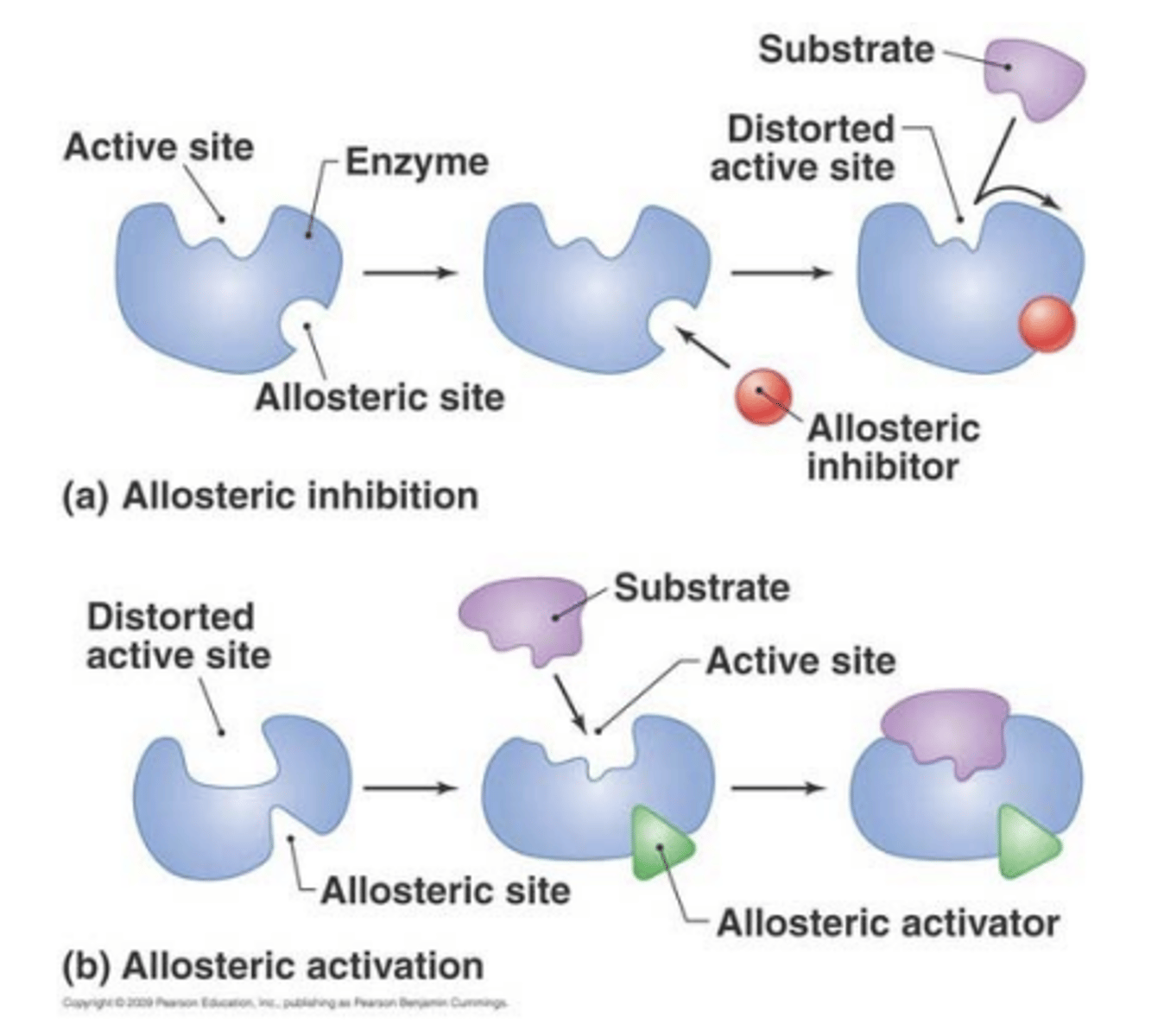
the 2 functions of receptors****
- sensing the ligand (binding)
- transmitting the message into cell
Most signal-transducing receptors are integral components of the cellular membrane: (2)
-what does this orientation permit?
- extracellular ligand binding domain
- intracellular signal transmitting domain
- permits chemical diversity in signaling molecules
Several signal-transducing receptors are found in the....
Most are present in ___________ numbers
cytoplasm or nucleus
- present in small numbers (few thousand per cell)
T/F: There are often many isoforms of an "individual" receptor
TRUE
(different isoforms may have different mechanism of signal transduction- regulatory flexibility)
4 types of receptors
- Ion channels (ligand gated, voltage gated)
- G-Protein Coupled Receptors (aka seven-(pass)-transmembrane domain receptors)
- Receptor tyrosine kinase
- Intracellular hormone receptors
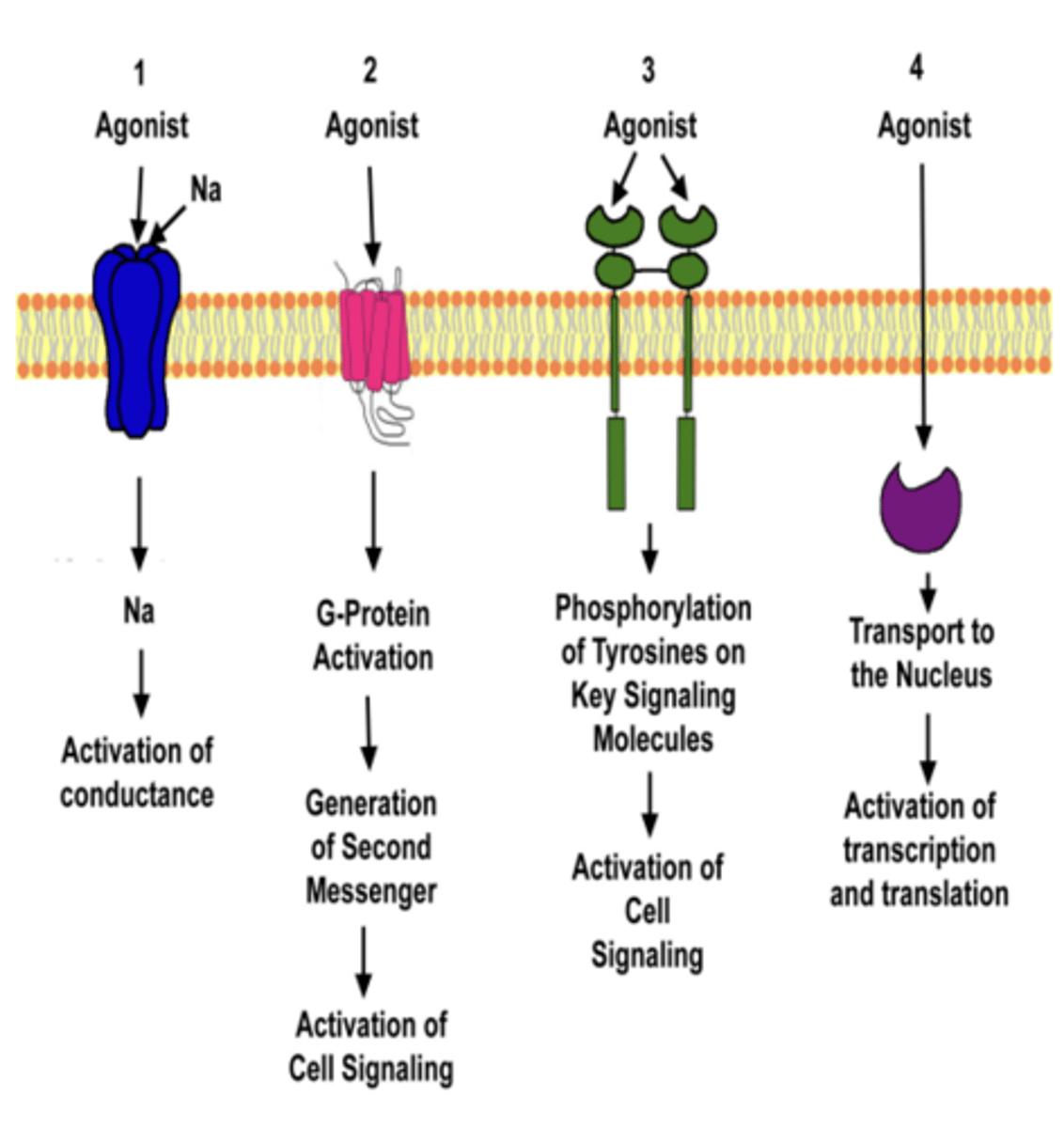
Neurotransmitter
what are they generated by? to do what?
chemical messengers that are generated by the nerve cell to transmit the message from the cell across the synapse to a target cell
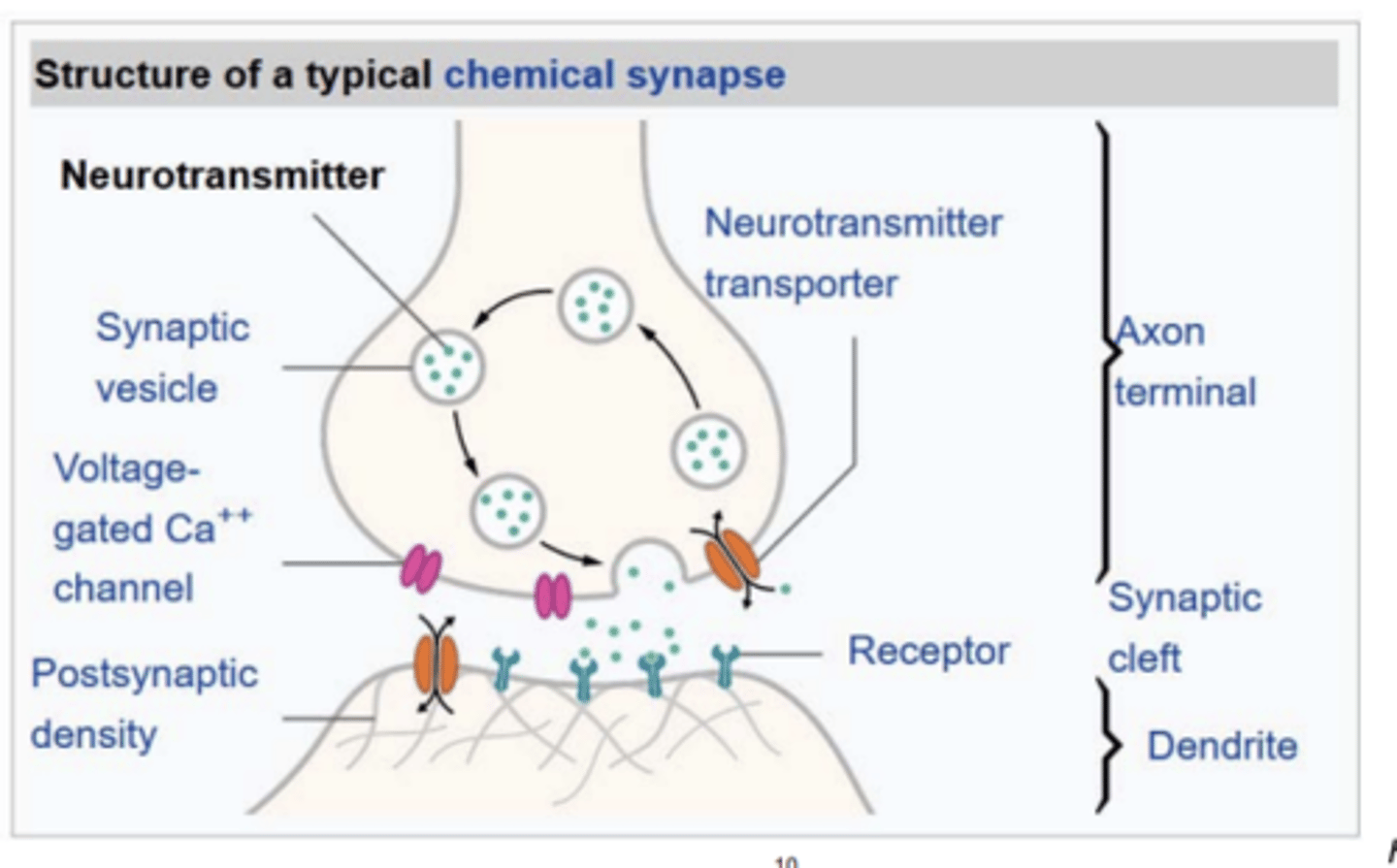
What can the target of a neurotransmitter be? (3)
another nerve cell, a muscle cell, or a gland cell
What are neurotransmitters released from? Where are they released into?
What are they received by?
- released from synaptic vesicles in synapses
- released into the synaptic cleft
- received by neurotransmitter receptors on target cell
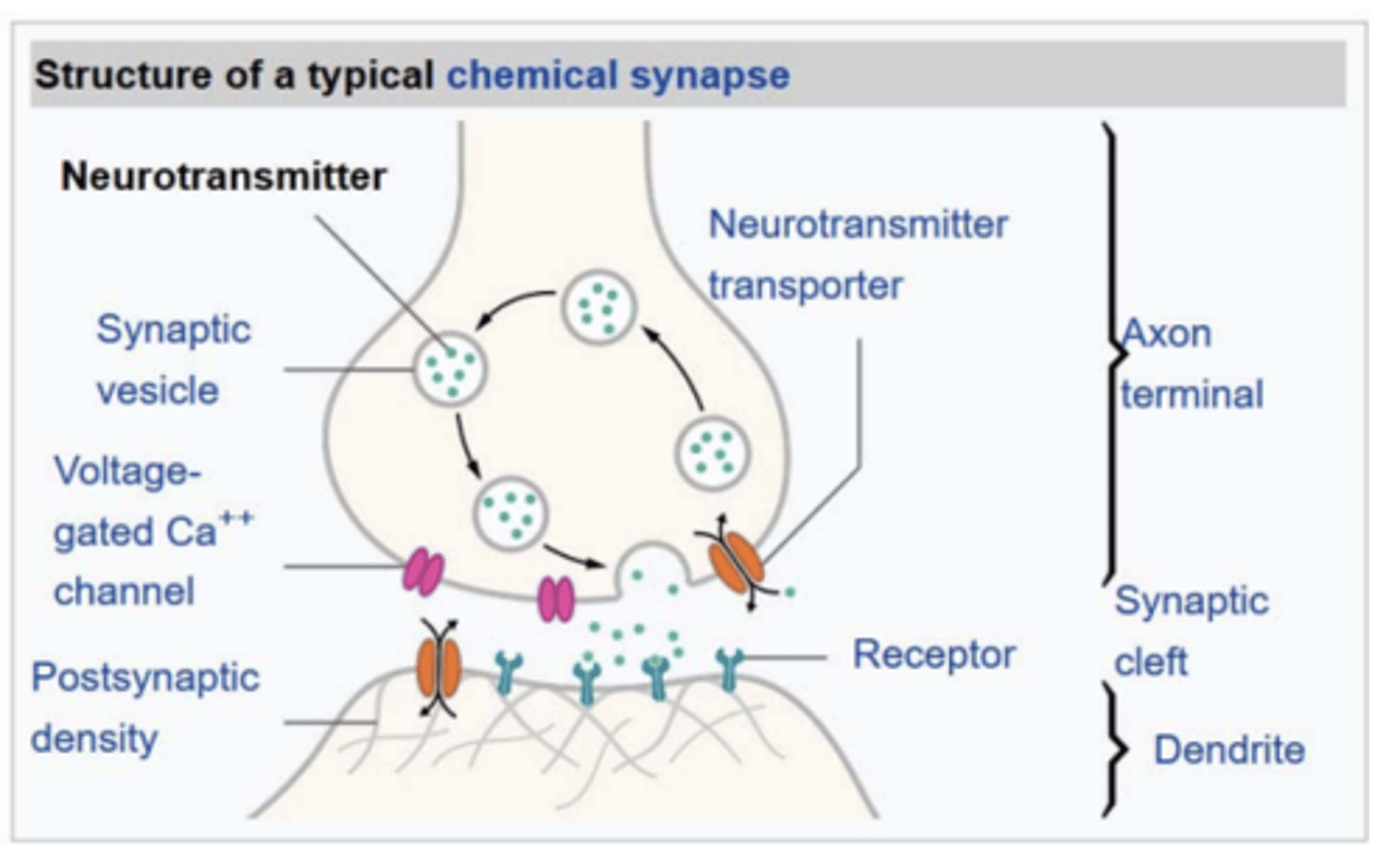
Neurotransmitters are classified into 2 categories:
Metabotropic and ionotropic receptors
Fast neurotransmission (ionotropic receptors)
- Responses to activation of receptors consisting of an ion channel tend to be rapid (milliseconds)
- effects are direct and generally do not require multiple steps leading to second-messenger generation and activation of a signaling pathway
Slow Neurotransmission (metabotropic receptors)
- Slower transmission (still fast, seconds)
- mediated by neurotransmitters that do not bind to ion channels (effectors and second messengers)
- Upon activation, these receptors generate second messengers
- consist of GPCRs
- other metabotropic receptors include tyrosine kinases and guanylyl cyclase receptors
Ionotropic receptors (Ion channels)
- needed to establish the electrochemical gradients required to maintain membrane potential
All cells express ion transporters for.....(4)
Na+, K+, Ca2+, and Cl-
What are passive ion fluxes down cellular electrochemical gradients regulated by?
a large family of ion channels located in the membrane
Ionotropic receptors are classified as 2 groups:
- Voltage-gated ion channel
- Ligand-gated ion channel
Voltage-gated ion channels
multisubunit protein complexes that respond to changes in membrane potential with conformational changes
- very fast response (milliseconds to seconds)
(leading to opening/closing)
(isoforms for Na+, K+, Ca2+, and Cl- ions)
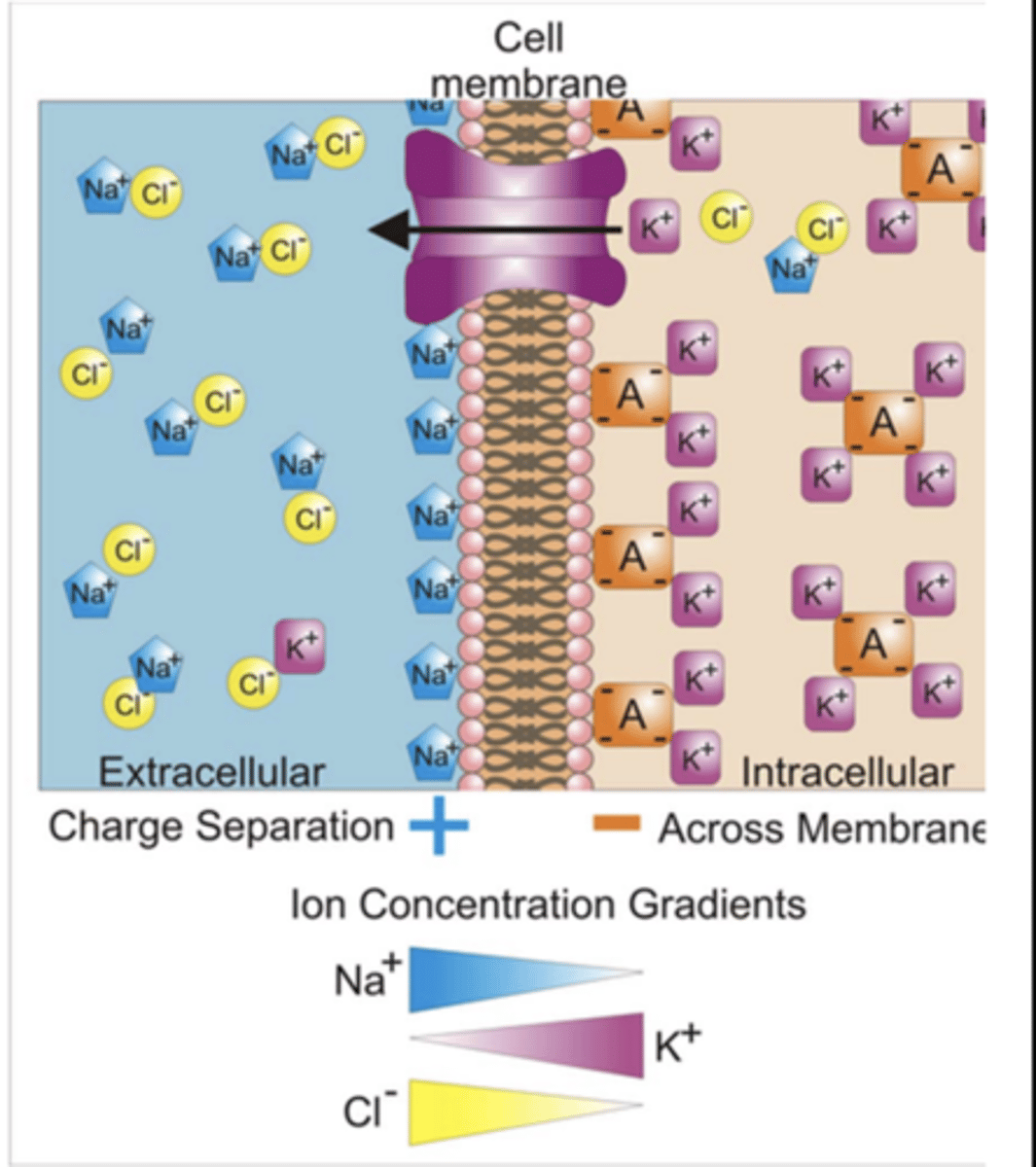
*******The sodium and potassium voltage-gated channel play crucial roles in....
regulating physiological function of nerves and muscle

********The voltage-gated calcium channels play crucial roles in...
neurotransmitter release in pre-synaptic nerve ending

Differences in the concentrations of ions on opposite sides of a cellular membrane lead to...
a voltage called the membrane potential
- typical values of membrane potential are in the range -40 mV to -70 mV
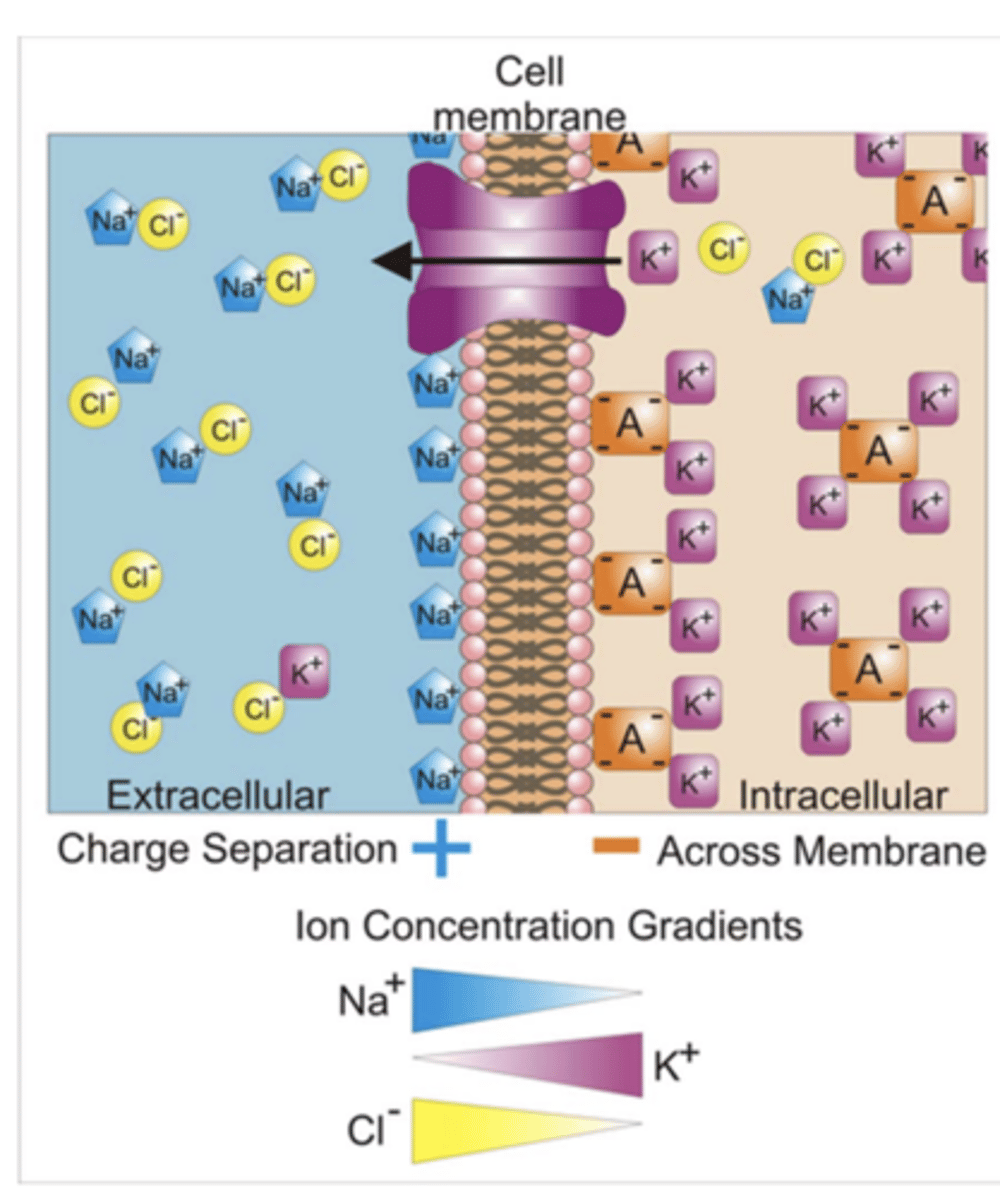
What is the voltage sensing portion of the ion channel responsible for?
for the detection of changes in transmembrane potential that trigger the opening or closing of the channel
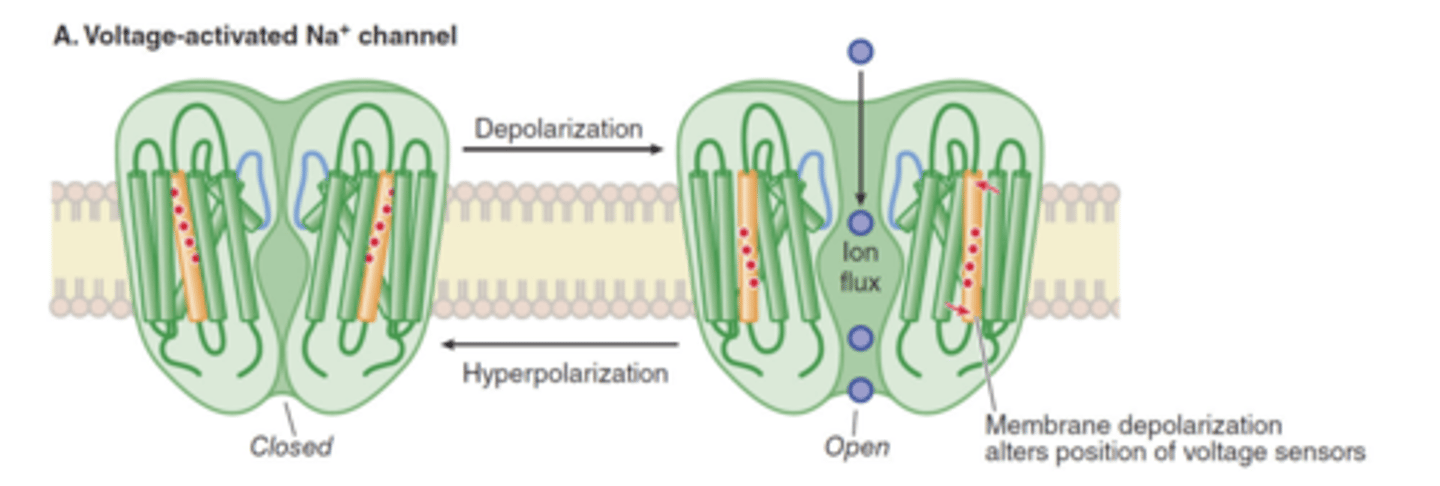
Movement of the voltage-sensor triggers a...
conformational change of the gate of the conducting pathway (controls the flow of ions through channel)
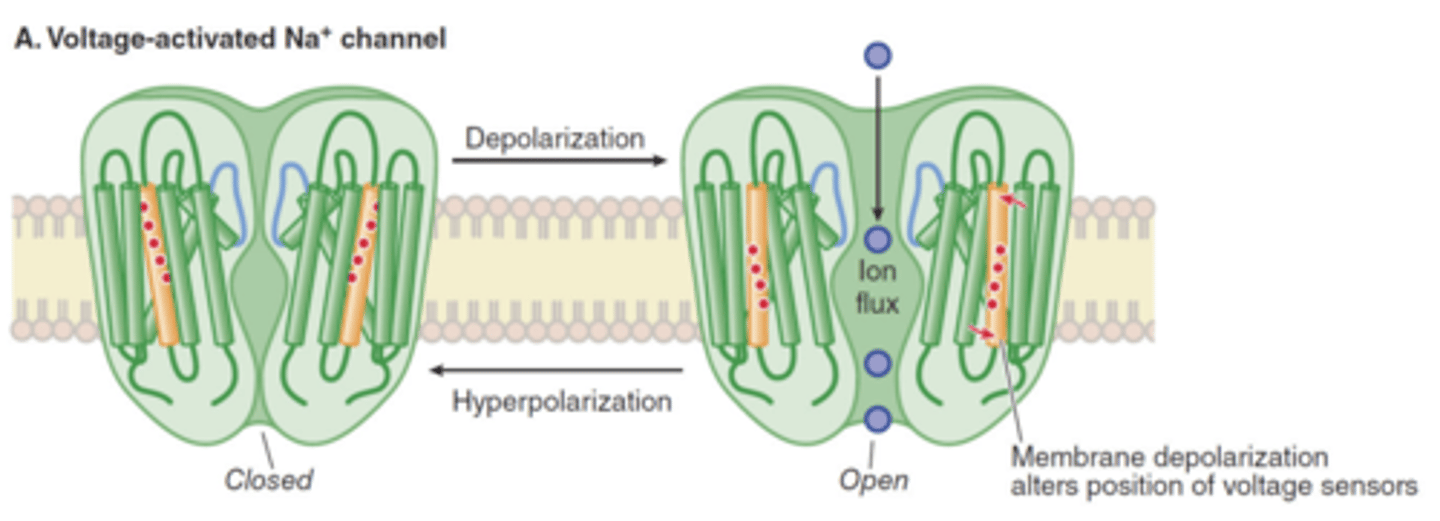
Inactivation of ion channels occurs within ________________ after opening. Inactivation is mediated by an ___________________ that controls the opening of the pore on the inside of the cell
- milliseconds
- intracellular gate
Ligand-gated ion channels
- activated by binding of ligand to specific site
- activation of channels is responsible for the majority of synaptic transmission by neurons both in the CNS and in the periphery
- specialized ion channels are activated by intracellular small molecules (IP3-sensitive Ca2+ channel, ER)
Examples of ligands (neurotransmitters) of ligand-gated ion channels (3)
- acetylcholine (Ach) (Nicotinic cholinergic receptor)
- Gamma-AminoButyric Acid (GABAA)
- Glutamate
The activation of the nicotinic ACh receptor allows the passage of both....
NA+ and K+ ions

Synapse
a gap that is present between two neurons
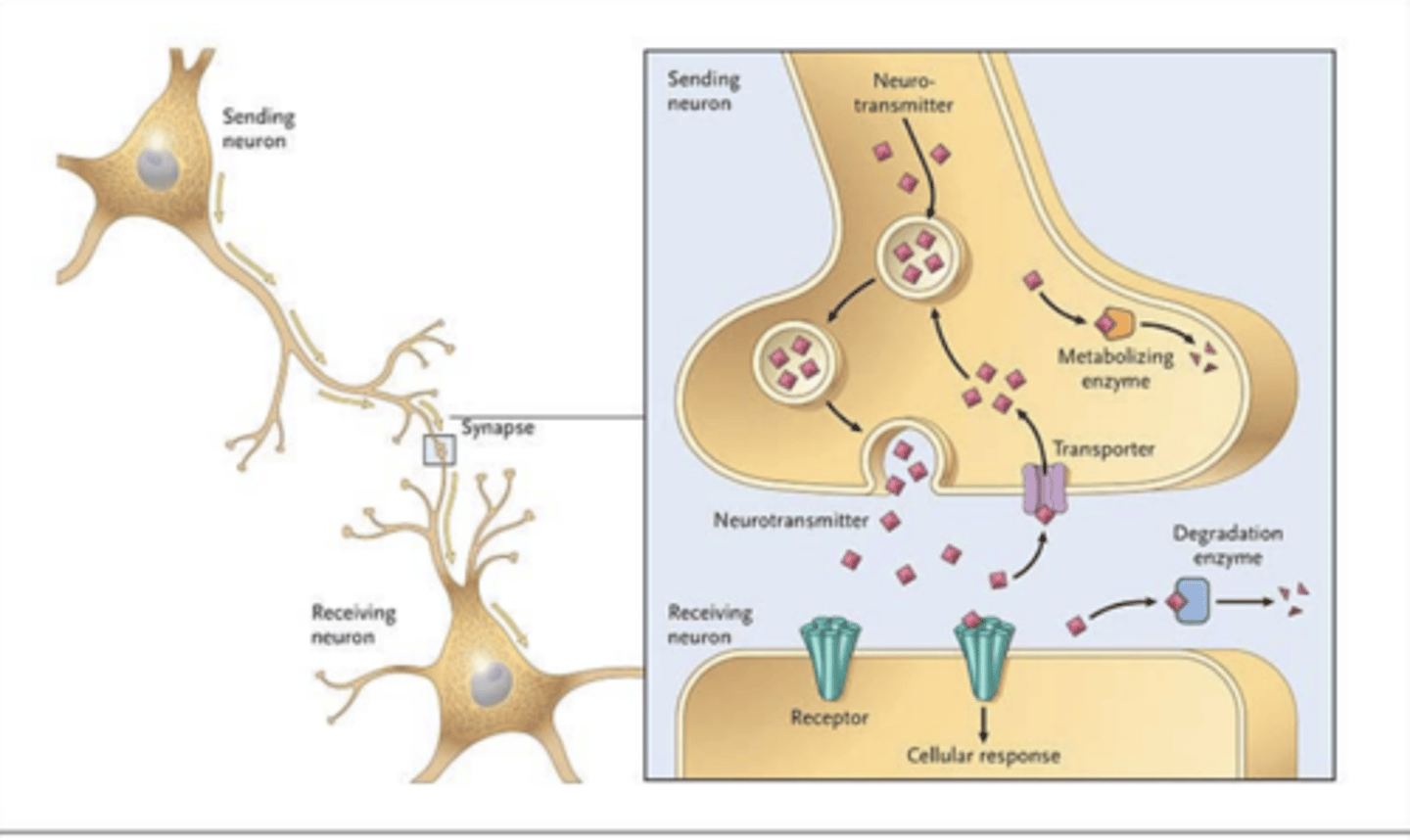
Action potentials are communicated across this synapse by......
synaptic transmission (neurotransmission)

The neurotransmitter diffuses across the synaptic cleft and binds to ___________________***** in the postsynaptic membrane, resulting in ________________ or ____________________ of the postsynaptic neuron
- ligand-gated ion channels****
- depolarization or hyperpolarization
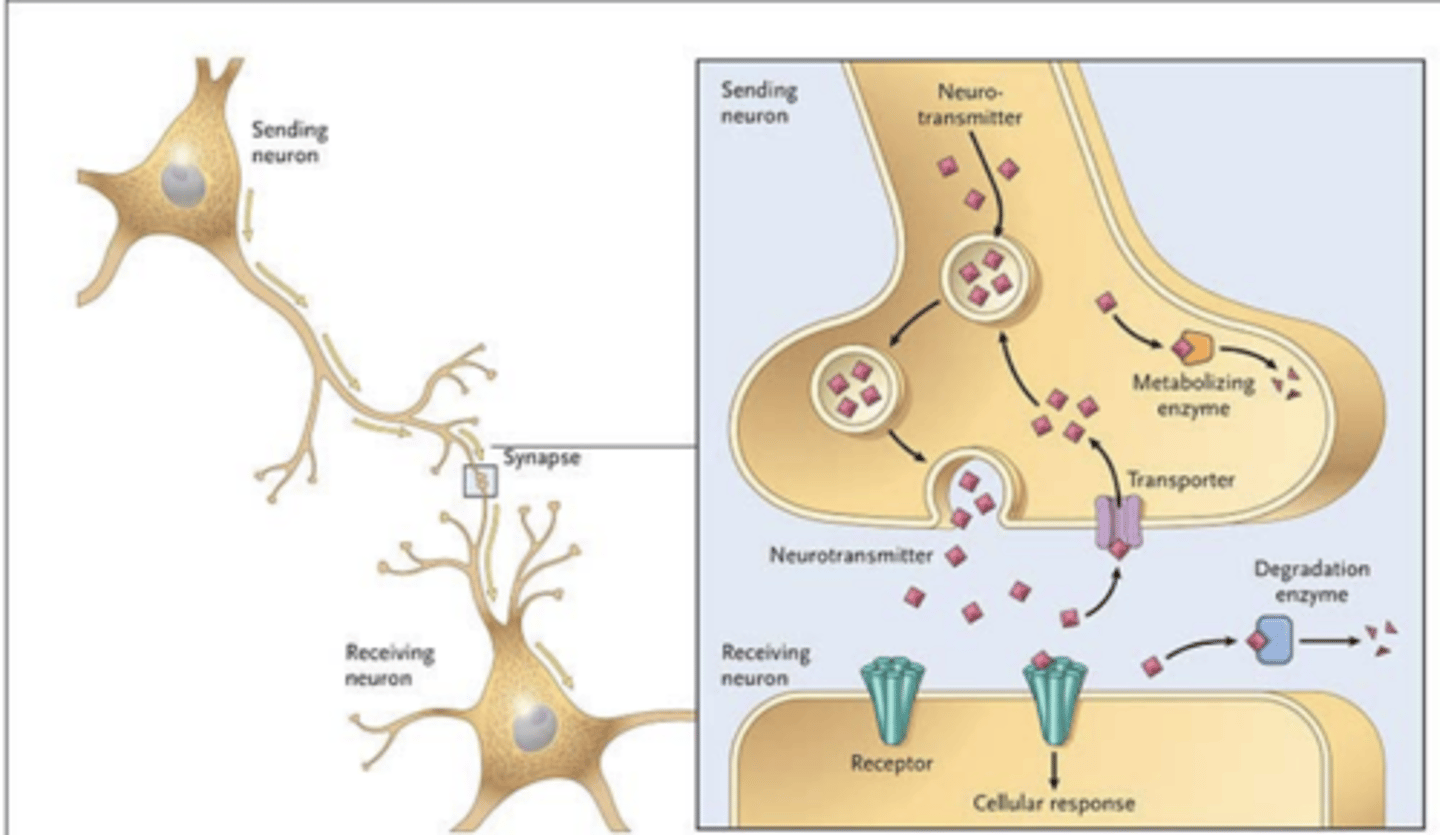
Metabotropic receptors are ____________ linked with ion channels on the membrane of the cell, often through ___________
- indirectly
- G protein coupled (transducer)
G protein-coupled receptors are inherently...
metabotropic
Metabotropic receptors (4)
- G-protein-coupled receptor (most)
- affects ion channels & 2nd messengers
- 2nd messenger can alter enzyme, effector proteins & DNA expression (effects on cell functioning)
- slow/long acting

Ionotropic receptors (4)
- permits flow of ions
- ligand-gated, (as opposed to voltage-gated channels in action potential)
- neurotransmitter can cause channel to open or close
- fast/short acting

G-Protein Coupled Receptors (GPCRs)
- signal transducers
- convey information (agonist binding) to effector proteins
- (effectors include adenylyl cyclase, phospholipases, plasma ion channel (Ca2+, K+)
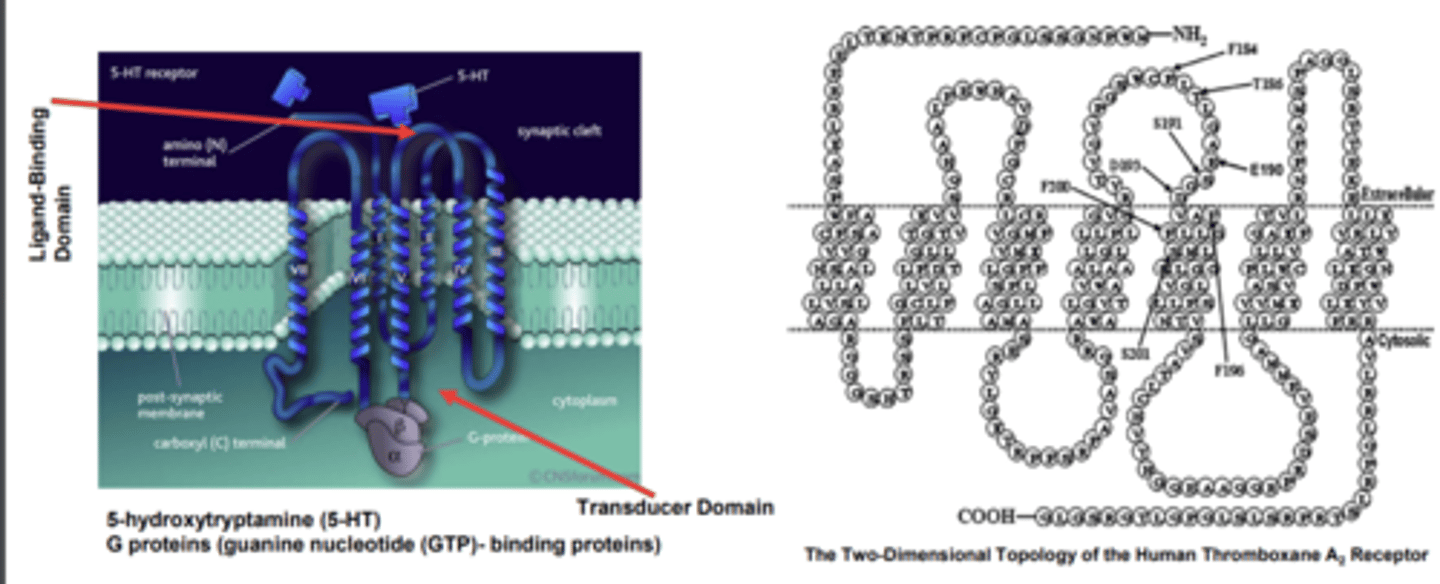
The GPCRs are a large family of signaling molecules that are known to...
activate heterotrimeric G proteins to regulate downstream effectors
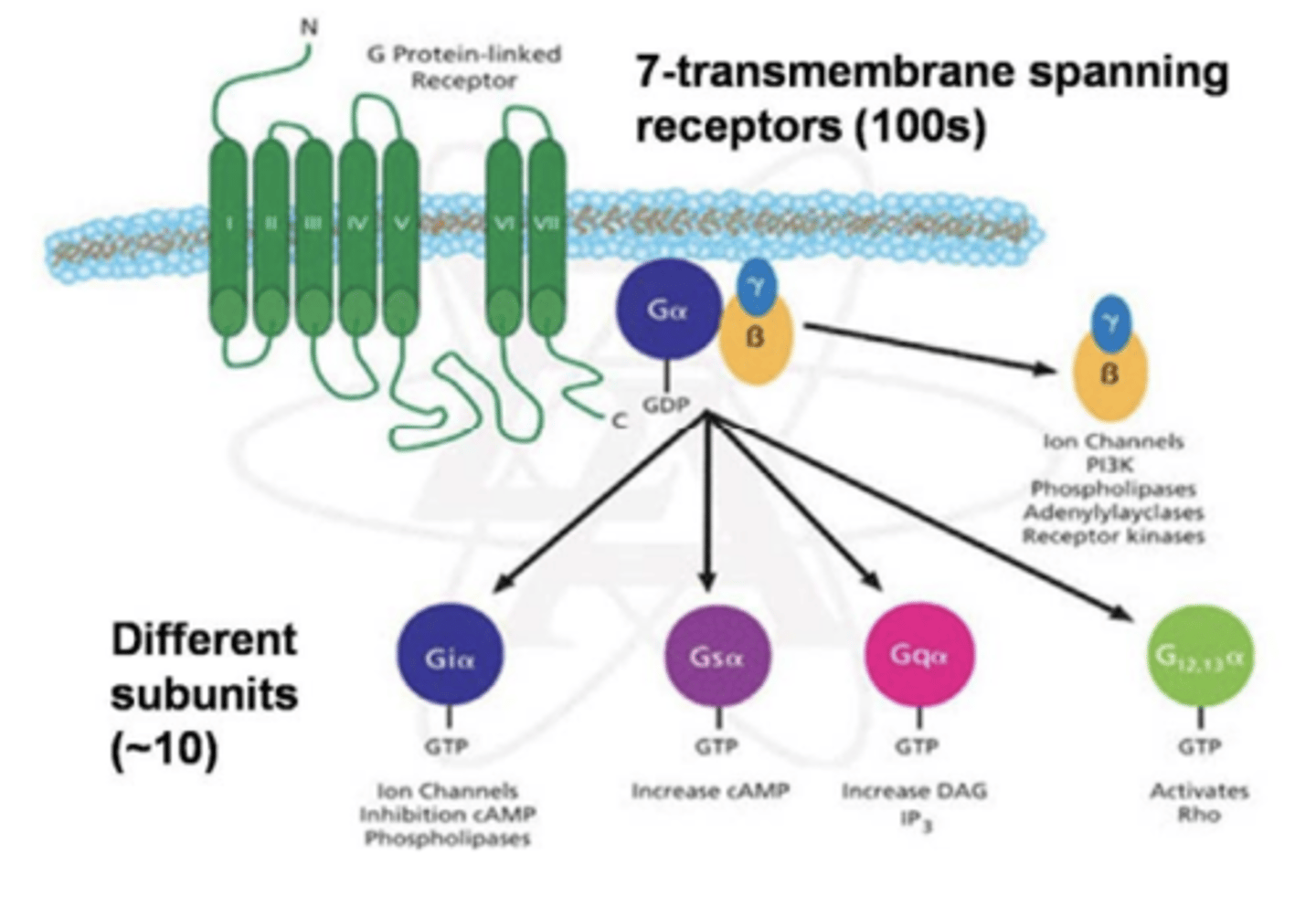
Effectors for G proteins
adenylyl cyclase, phospholipases, plasma ion channel (Ca2+, K+)
The agonist-induced GPCR activation is a change in what?
the relative orientations of the TM helices leading to a wider intracellular confirmation changes (crucial to signal transduction function)

The G-Protein Regulatory Cycle (6)
1. Drug binds receptor
2. induces conformational change/activation of receptor
3. G-protein cycle initiated with GTP replacing GDP
4. the heterotrimer dissociates from receptor, and activates effectors/signaling
4. GDP will now replace GTP on the G-protein
5. the heterotrimer re-assmbles and re-couples to the receptor
6. ready to start the signaling cascade again when drug binds

G Protein-coupled Receptors
Upon activation by a ligand, the receptor binds to a partner_______________________ and promotes exchange of _______ for ______, leading to ________________ of the G protein into α and βγ subunits that mediate _________________
- heterotrimeric G protein
- GTP for GDP
- dissociation
- downstream signals
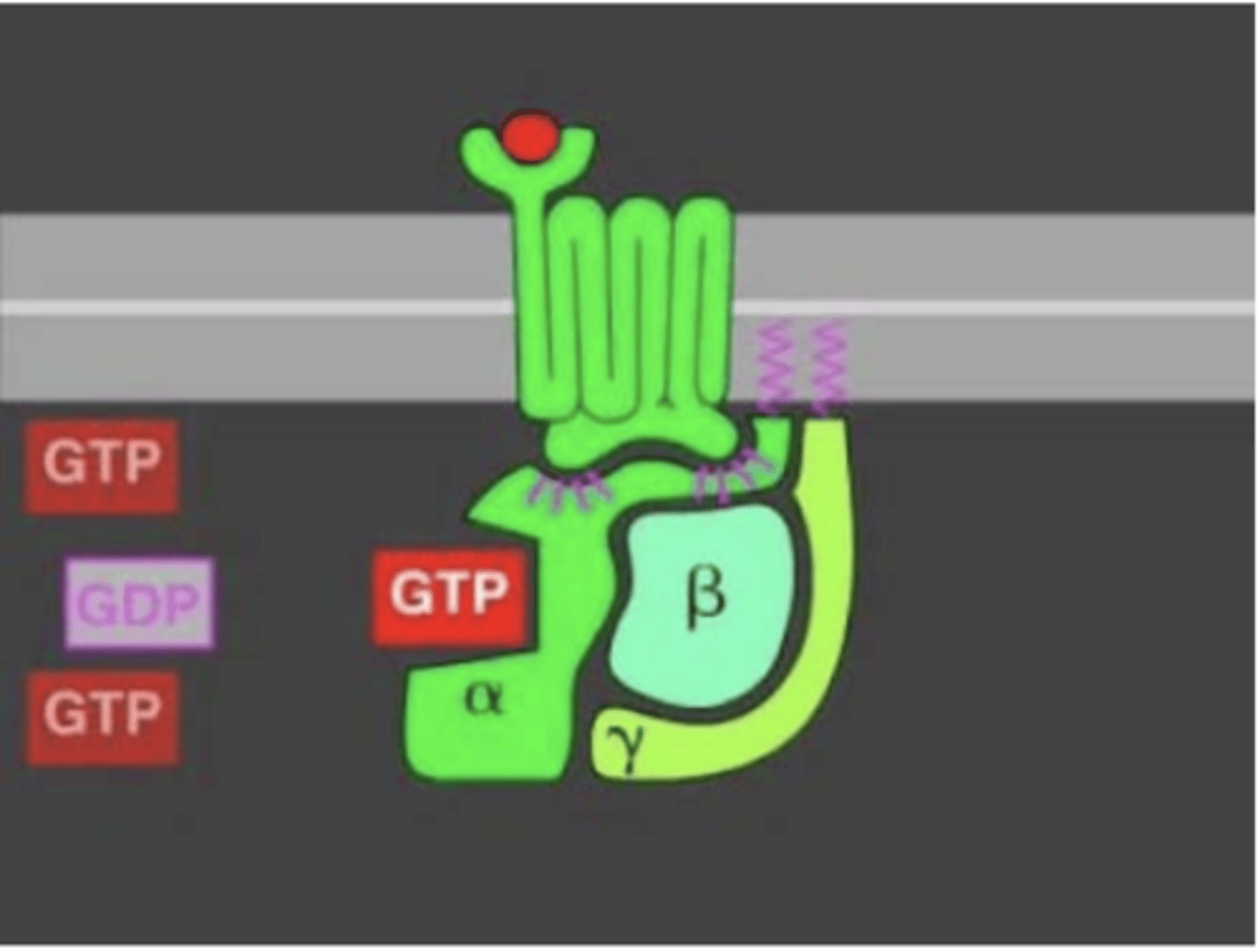
Enzyme/Kinase-Linked Receptors
- linked directly or indirectly to an enzyme (or enzymatic activity)
- signal transduction requires this enzyme/enzyme activity
- slow acting (hours-days)
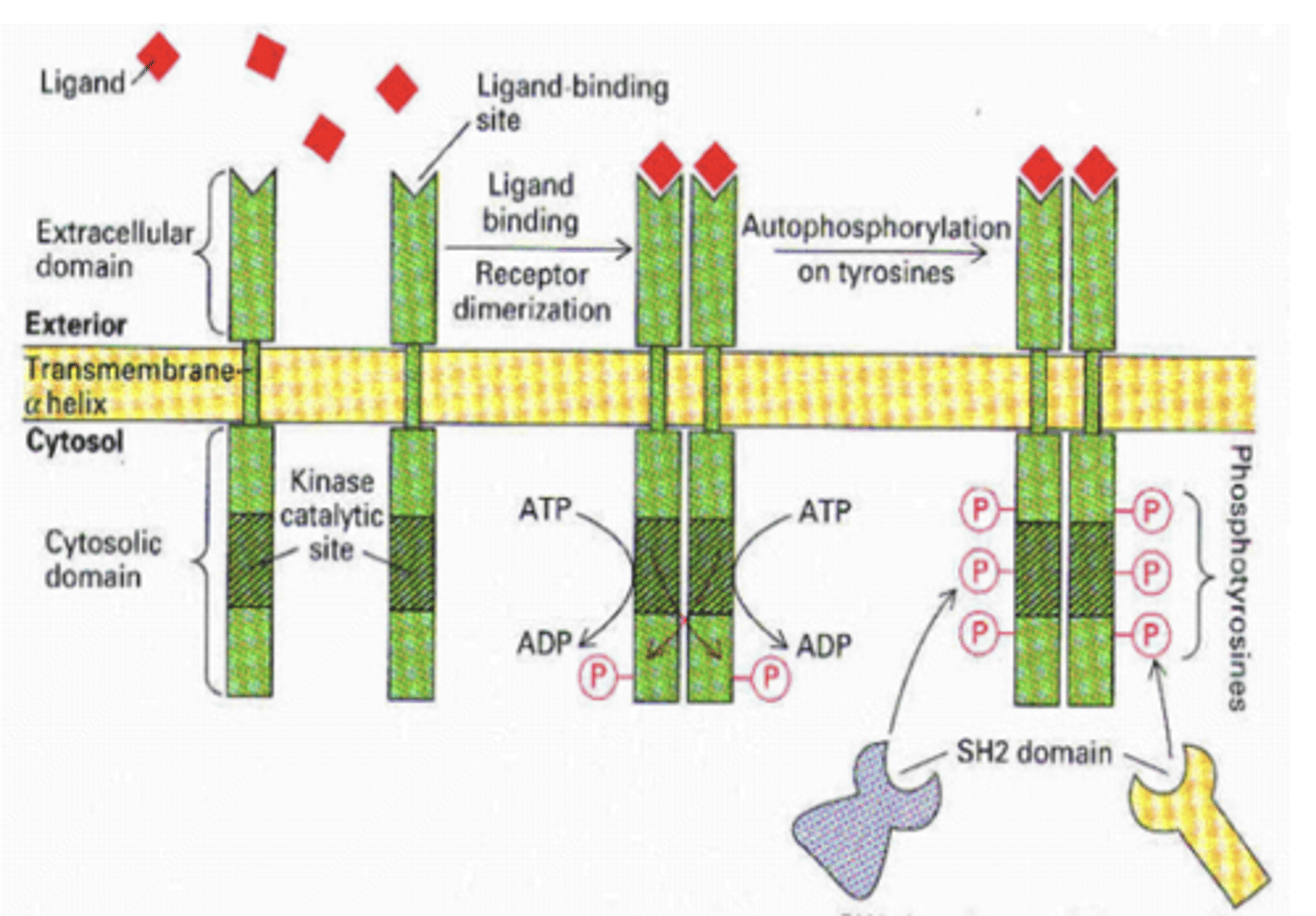
Protein kinase receptors
high-affinity cell surface receptors for many polypeptide growth factors, cytokines, and hormones
Majority of kinase receptors are....
receptor tyrosine kinases (RTKs).
(a small group of kinase receptors are receptor serine/threonine kinase (RTSK))
A transmembrane receptor (R) whose intrinsic enzymatic activity (in its cytoplasmic domain) is allosterically regulated by a ligand that binds to its _______________________, leading to __________________ and thus ________________
- extracellular domain
- R dimerization and thus R activation
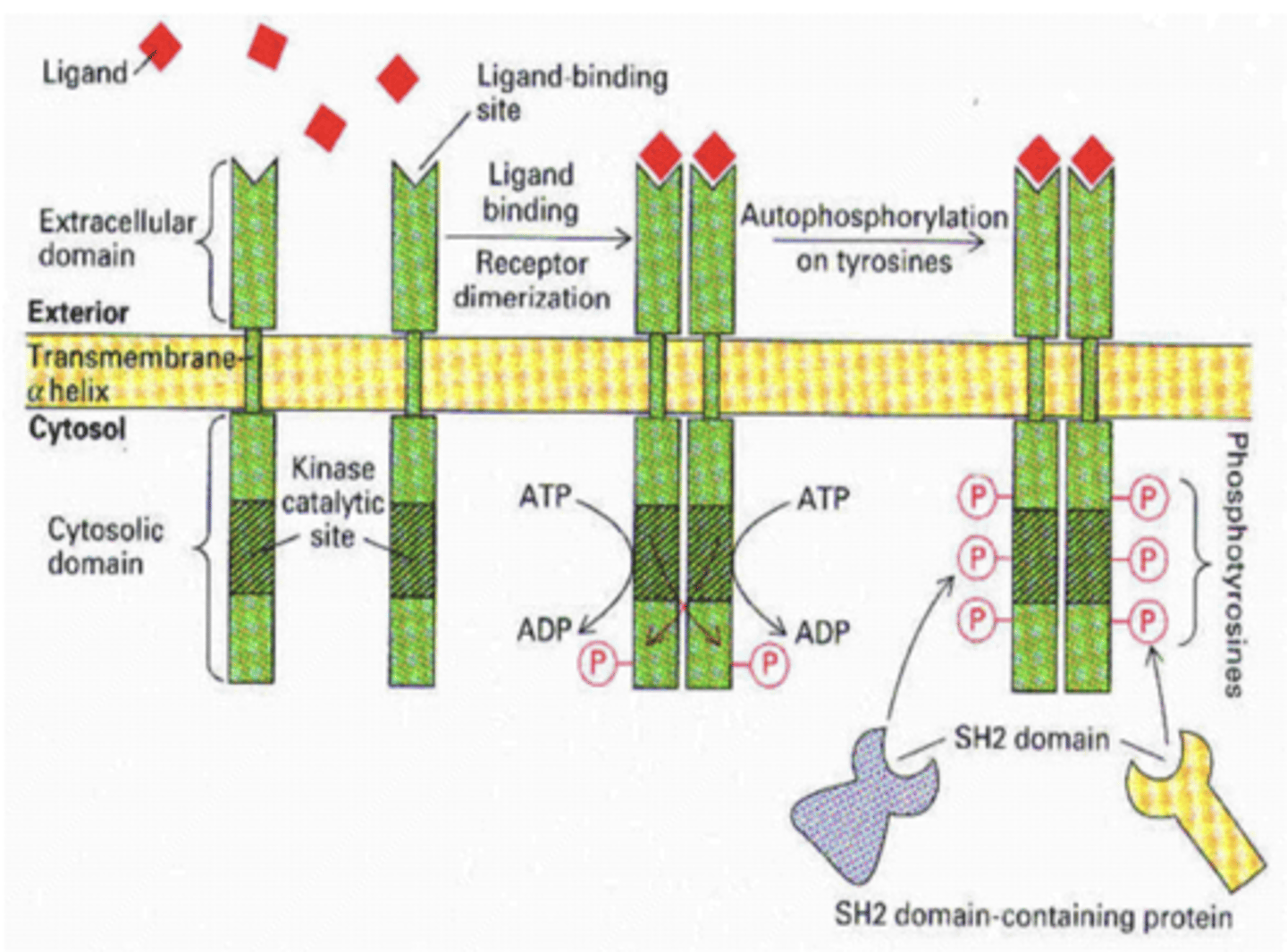
autophosphorylation***
- RTKs are activated by ligand-induced oligomerization (dimerization), which juxtaposes the cytoplasmic tyrosine kinase domains
- The activated tails then phosphorylate each other on several tyrosine residues
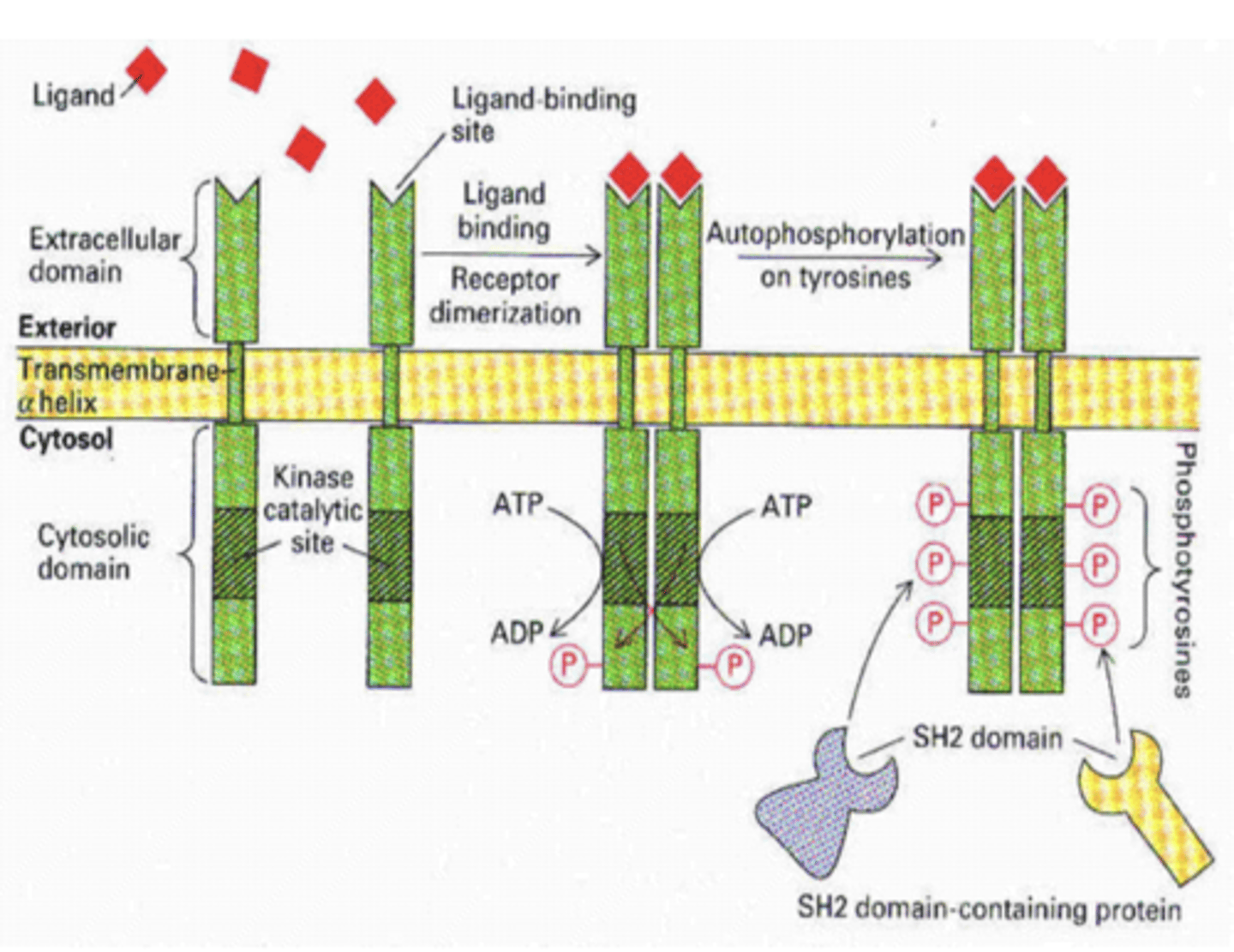
Enzyme-Linked Receptors: Interferon Gamma Receptor (IFNY)
- IFNY binds to receptor; leads to dimerization
- JAK is activated and phosphorylates Stat1
- Stat1 forms dimers and becomes active
- active stat enter nucleus and activates transcription
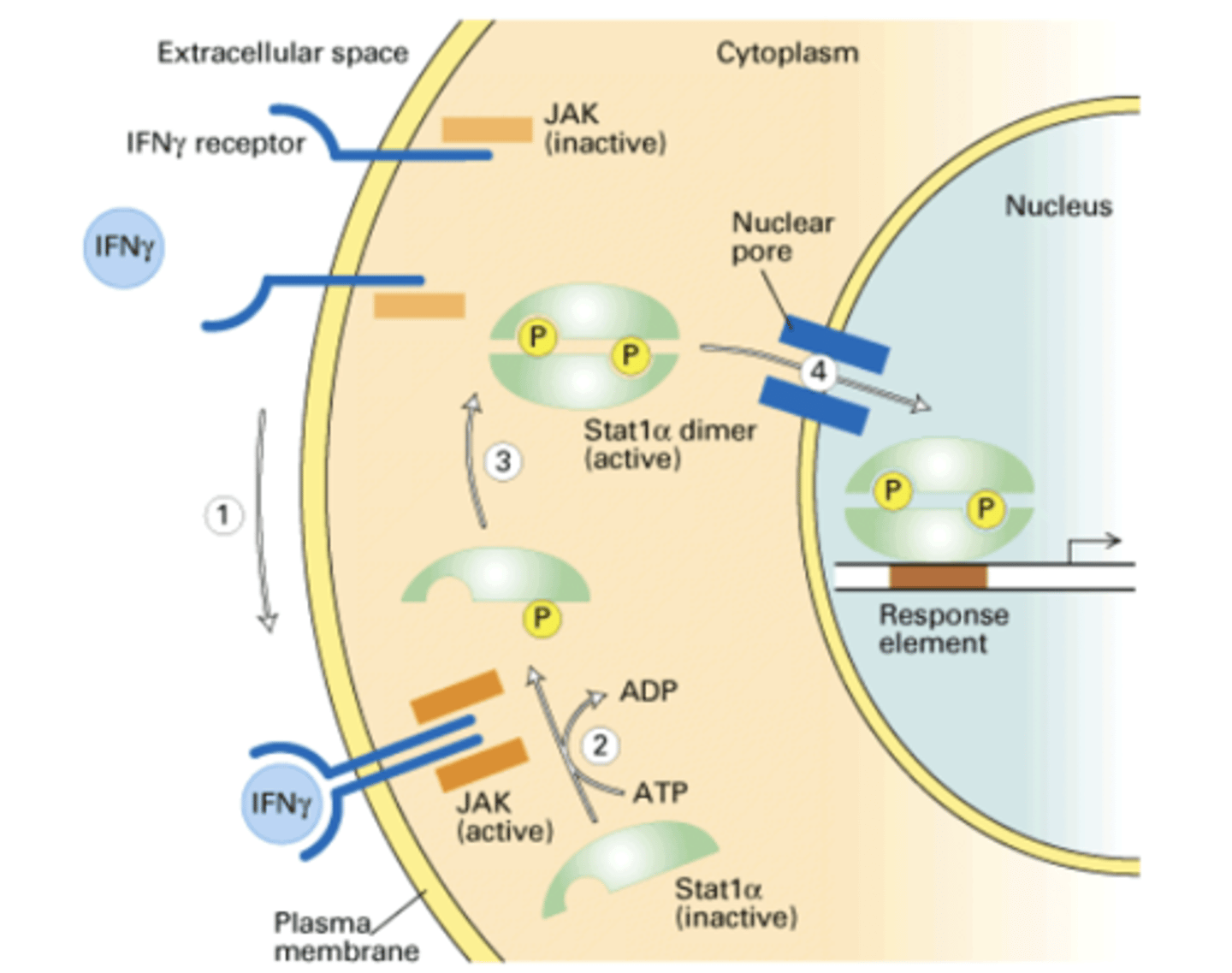
Enzyme-Linked Receptors: Guanylyl Cyclase Receptors
enzyme Guanylyl Cylase (GC) is a receptor, with an extracellular binding domain and intracellular guanylyl cyclase (catalytic/enzymatic) domain
- cGMP is an important second messenger
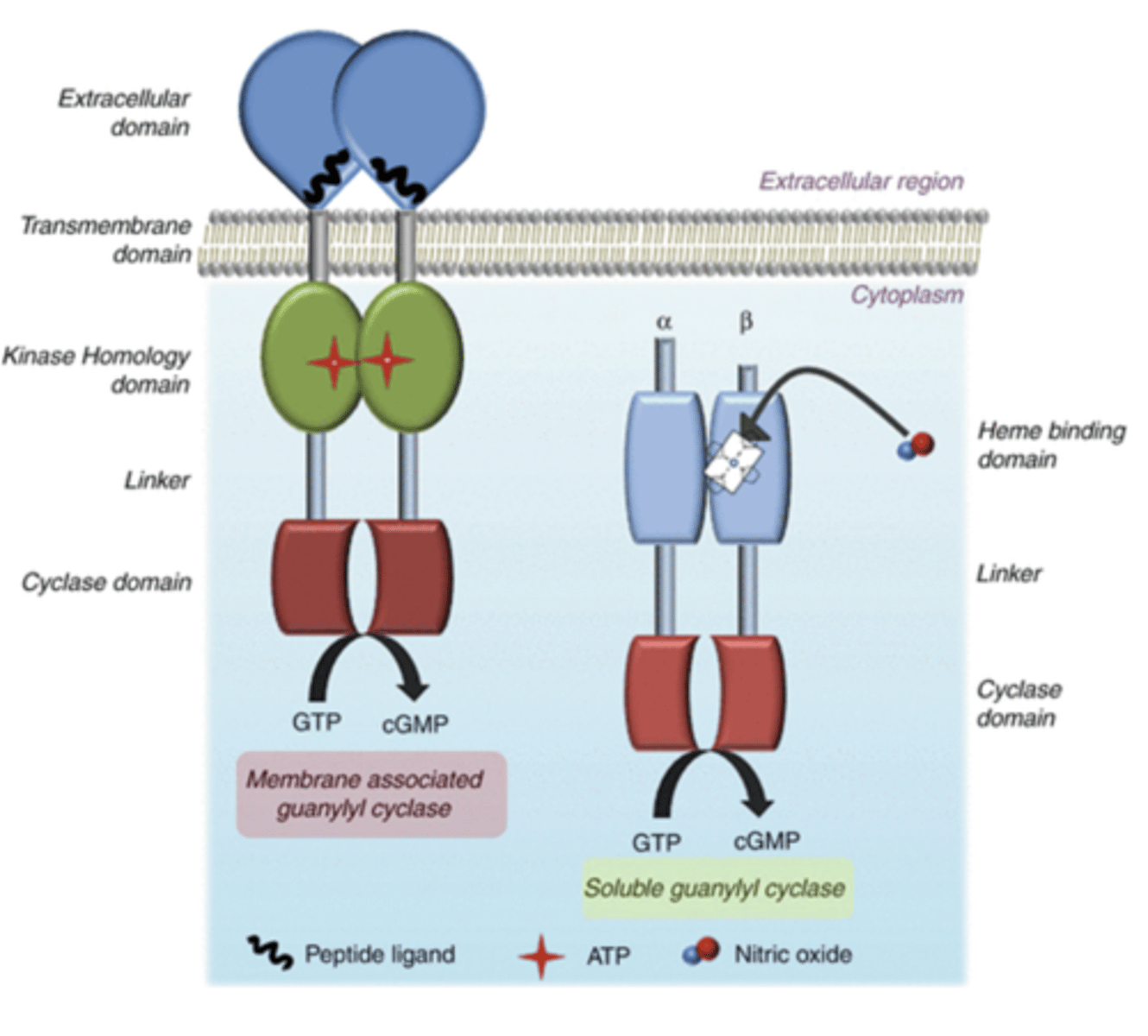
Intracellular receptors
- located inside cell (or even inside nucleus)
- ligand will have to penetrate the plasma membrane (lipid-soluble) to reach its receptor
- ligand binding induces gene transcription
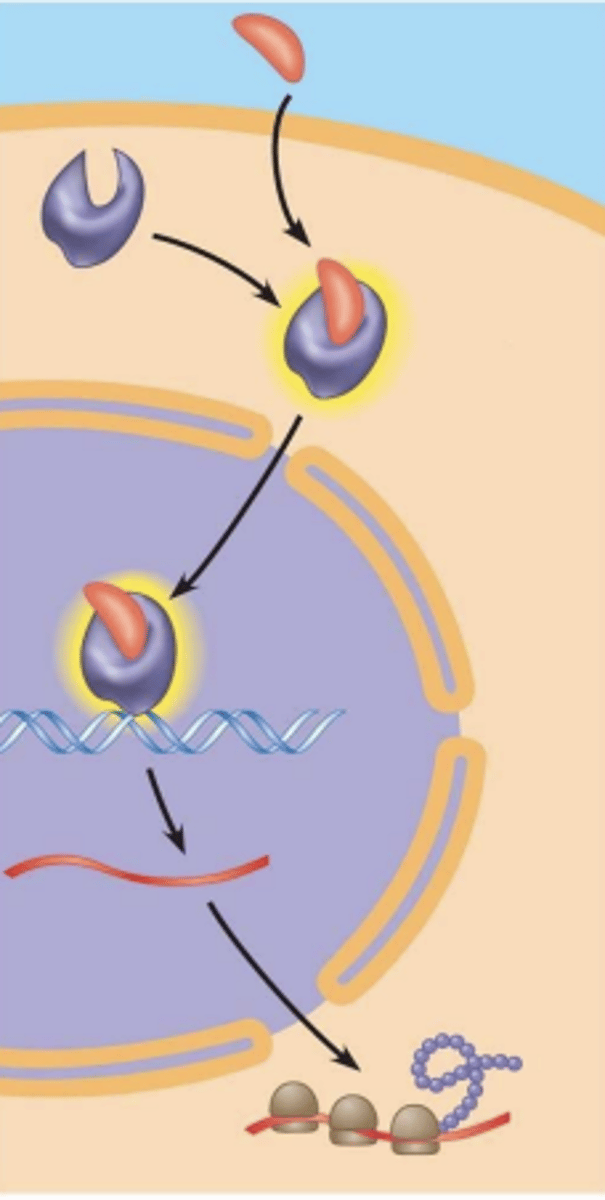
Examples of intracellular receptors (2)
- nuclear receptors
- IP3 receptor located on the ER
Intracellular receptor ligand examples (2)
- classic hormones (thyroid & steroid hormones)
- intracellular second messengers like inositol triphosphate (IP3)
A ________________________ ligand/drug can cross the membrane to act on an intracellular receptor
lipid-soluble (hydrophobic) (enzyme or regulator of gene transcription)
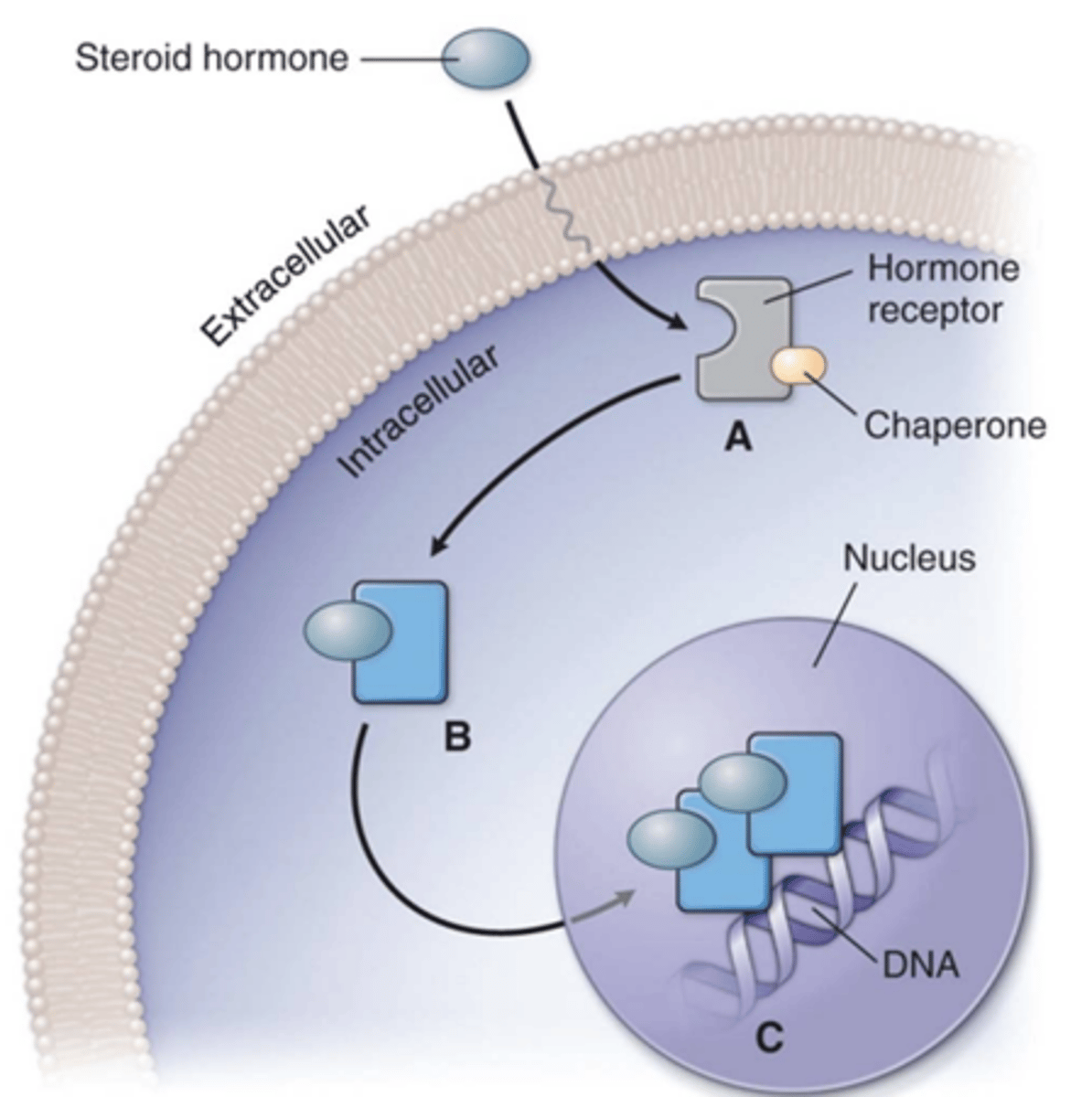
Nuclear receptor may contain...(3)
- ligand binding domain
- DNA binding domain
- regulatory domain
Nuclear receptors (NRs)
class of transcription factors responsible for sensing steroid and thyroid hormones and other messenger molecules
Activated NRs regulate....
expression of specific genes
(controlling the development, homeostasis, and metabolism)
Nuclear Receptor Type I*****
- located in the cytosol in the absence of ligand
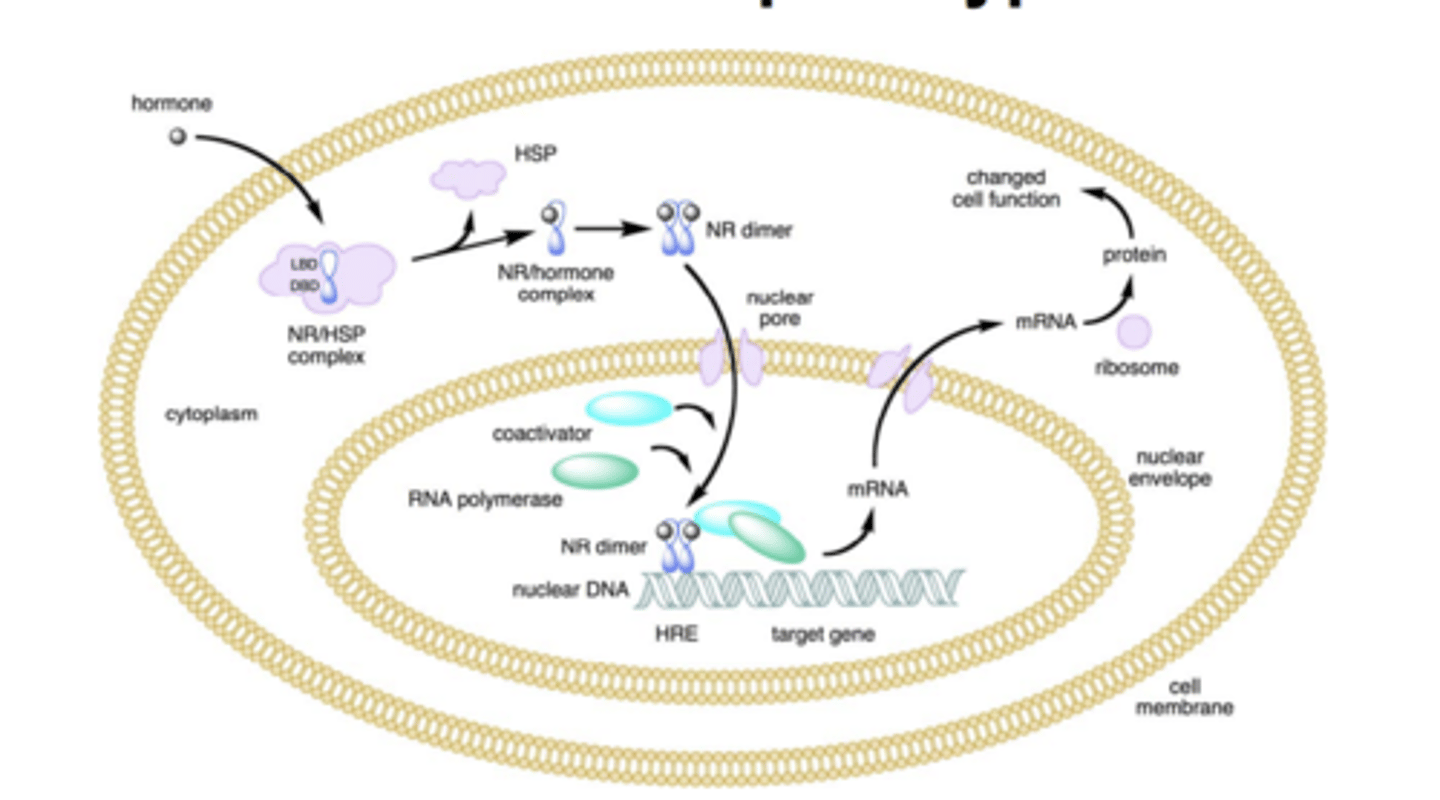
Nuclear Receptor Type II****
- located in the nucleus bound to DNA regardless of ligand-binding status
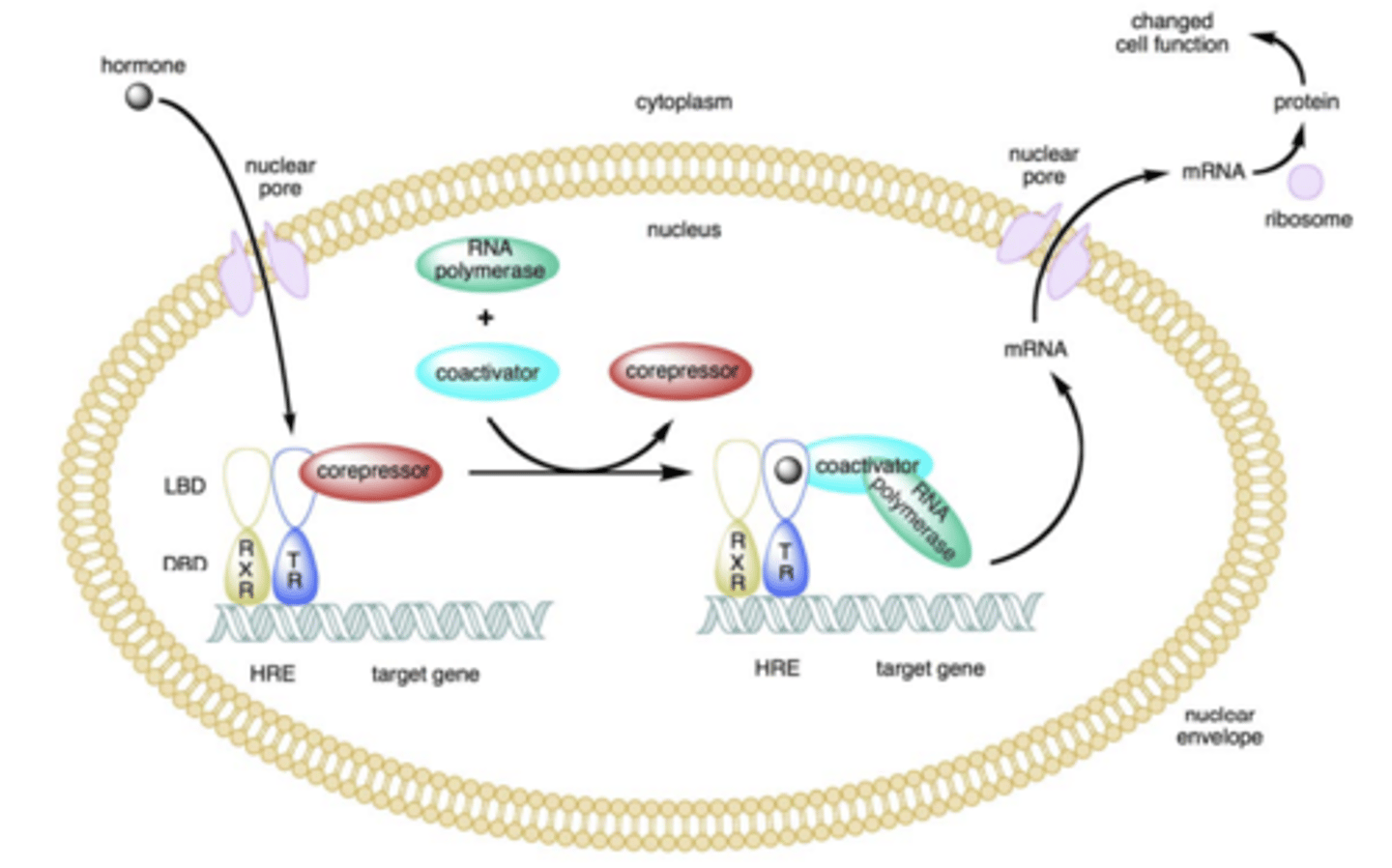
Catalyst
accelerates the process but it not consumed by the reaction
Receptors as "Catalysts"
- enzymatic receptor
- ion channel (flow of millions of ions)
- receptors for steroid hormones (NRs-transcription of copies of mRNA)
Receptors and their associated effector/transducer proteins act as ___________________ from multiple ligands
integrators of information
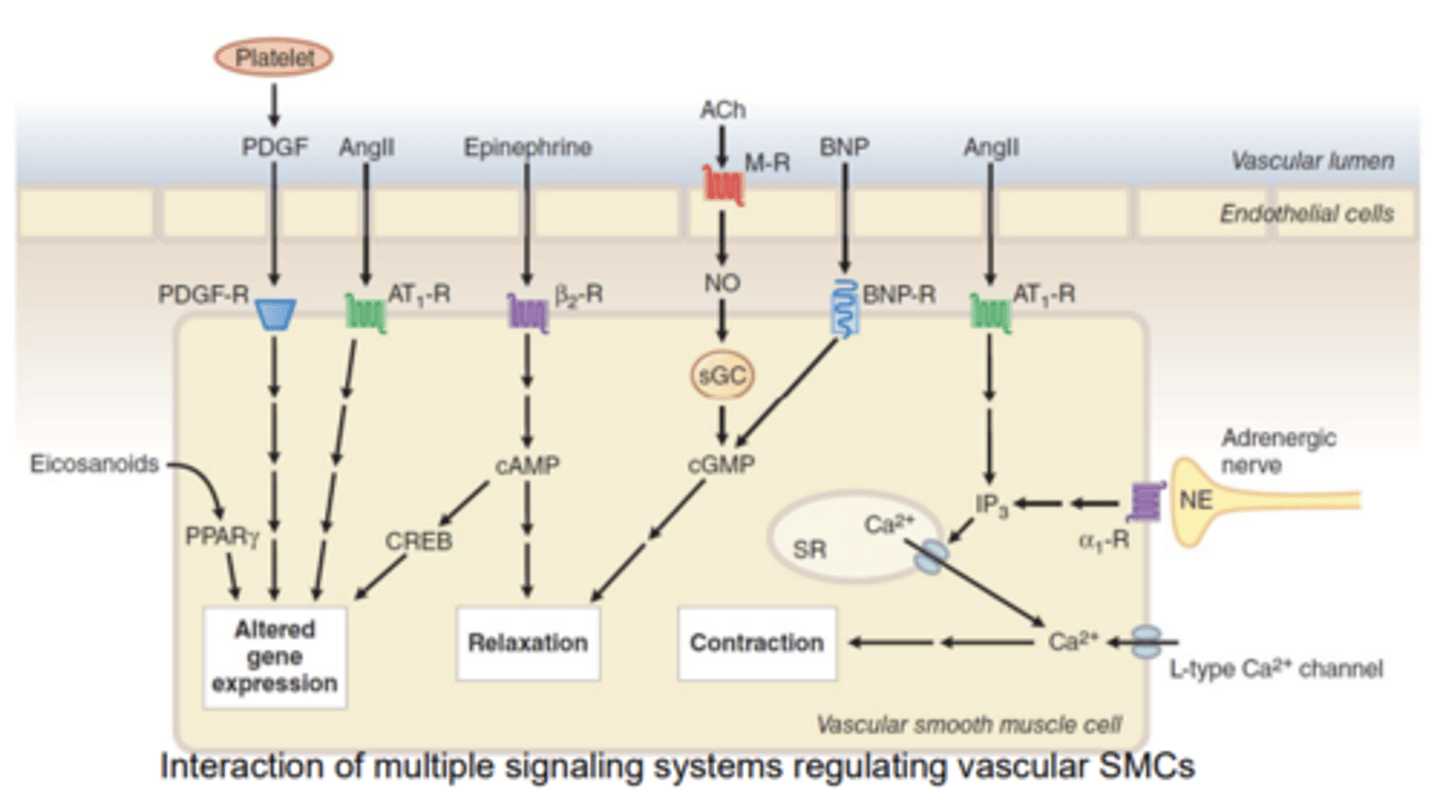
Convergences in resistance to targeted therapy: BRAF-mutant melanoma
- drug blocks BRAF, but it can still go through other mechanisms
a GPCR-cAMP-CREB signaling axis can substitute for MAPK signaling to sustain an MTD-driven program
- MITF amplification can render MITF independent of MAPK signaling
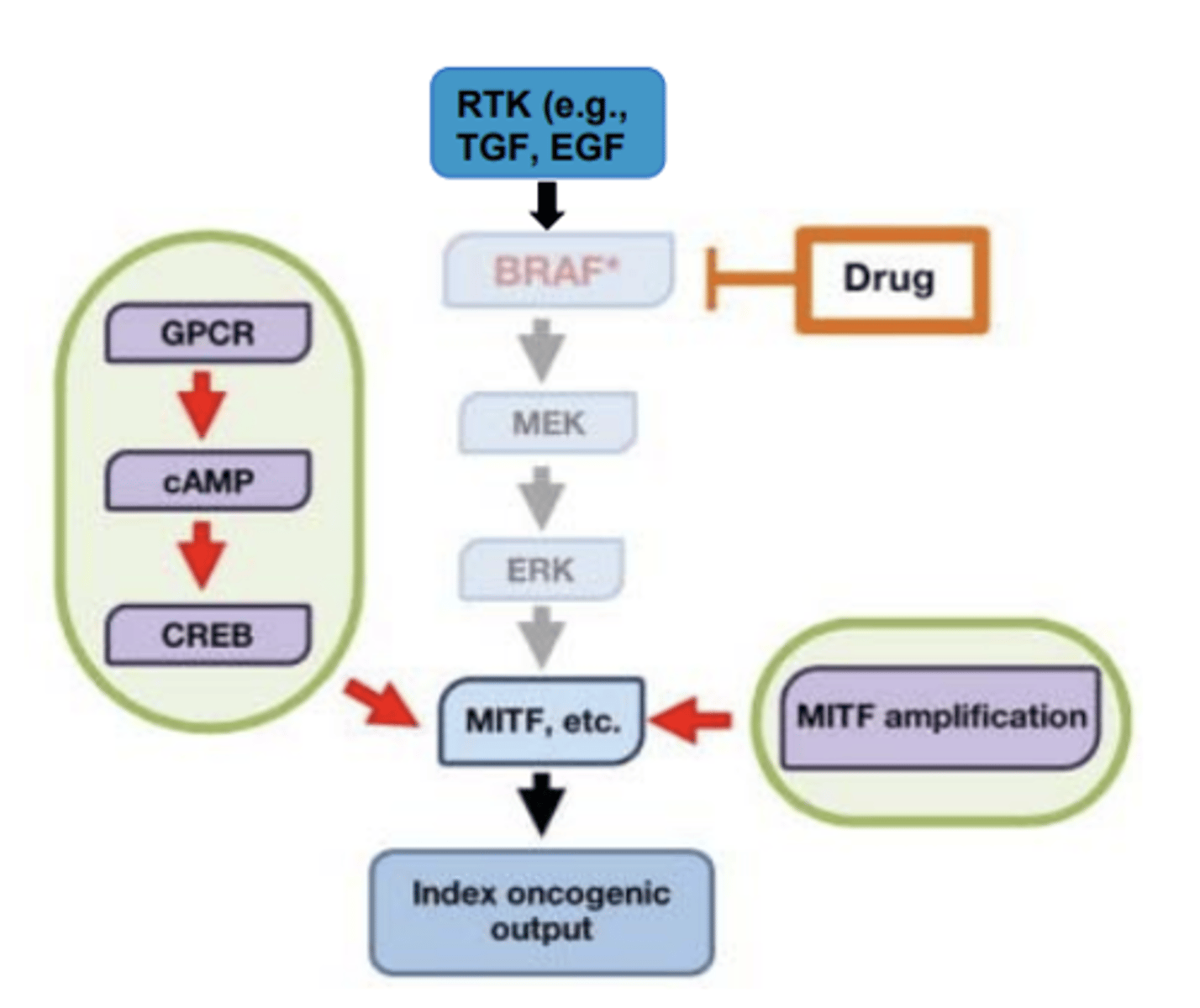
Due to the variety of pathways regulating the same physiological function, a patient may be treated with......
one or several drugs that alter signaling through these pathways
T/F: There are many mechanisms used to transduce intracellular signal cascades
FALSE
there's a limited number of mechanisms
Crosstalk between signaling pathways:
one or more components of one signal transduction pathway affects another
- (allows for convergence in some cases)
Convergence ****
multiple signaling pathways converging on the same target
What will happen when 2 different receptors have opposite effects in the cell?
They tend to negate one another
Signals transmitted from a GPCR, an _________________, and a ______________ all converge on _________, and then activated the ____________________________
- integrin receptor
- receptor tyrosine kinase
- Ras
- MAP kinase cascade
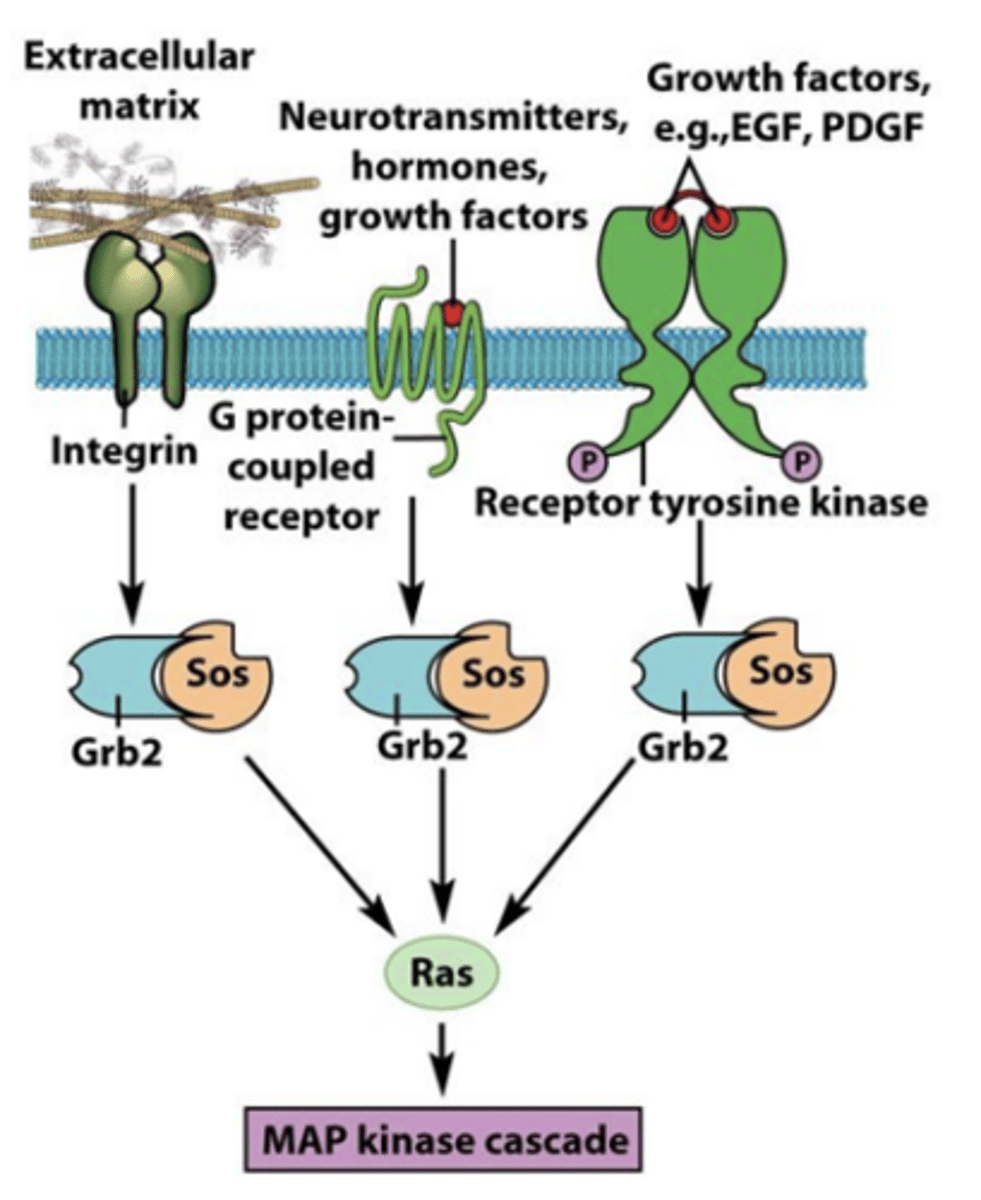
How were receptors identified? (4)
1. Structure-activity relationship
2. Binding of radioactive ligand
3. Molecular cloning
4. Genome project (reverse pharmacology)
Example of structure-activity relationship: Epinephrine and norepinephrine*****
epinephrine and norepinephrine differ only by one methyl group
- both can stimulate the heart with roughly equal potency
- epinephrine is a much better bronchodilator
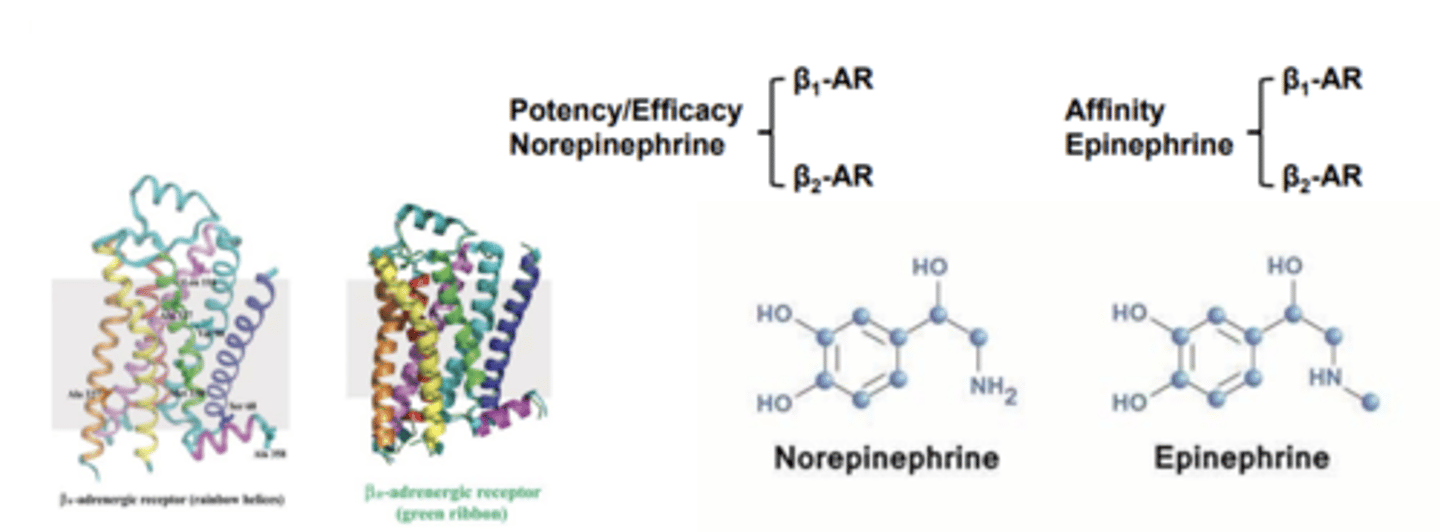
Cardiac cells contain predominantly _______________________. whereas bronchial smooth muscle cells contain __________________
- B1-adrenergic receptors (norepinephrine targets)
- B2-adrenergic receptors (epinephrine targets for bronchodilation)
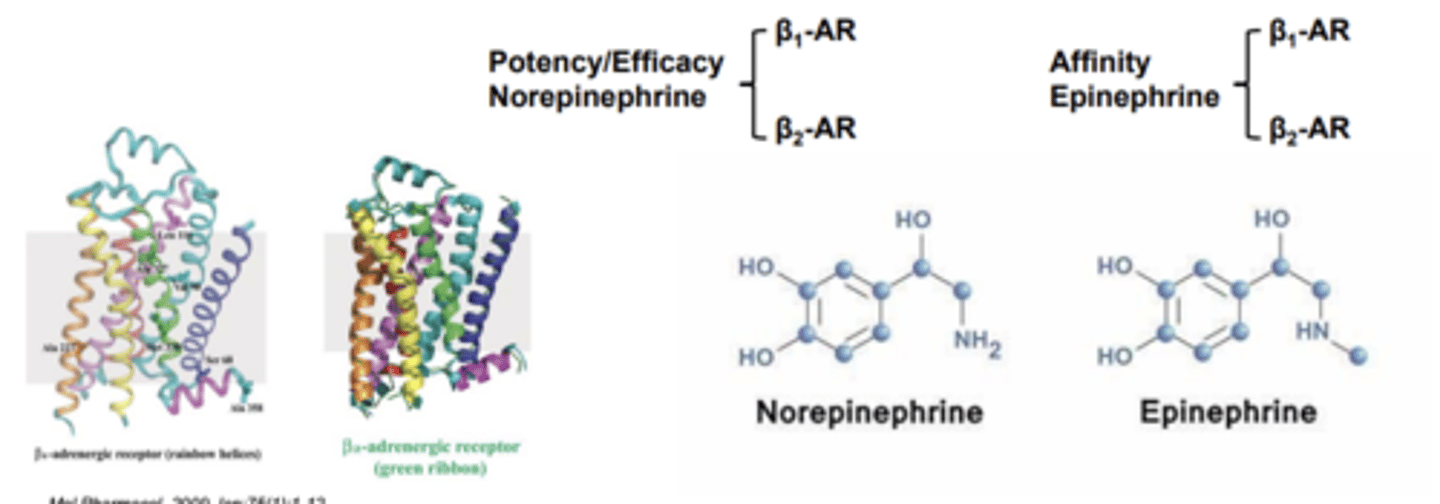
Characterization of receptors diagram
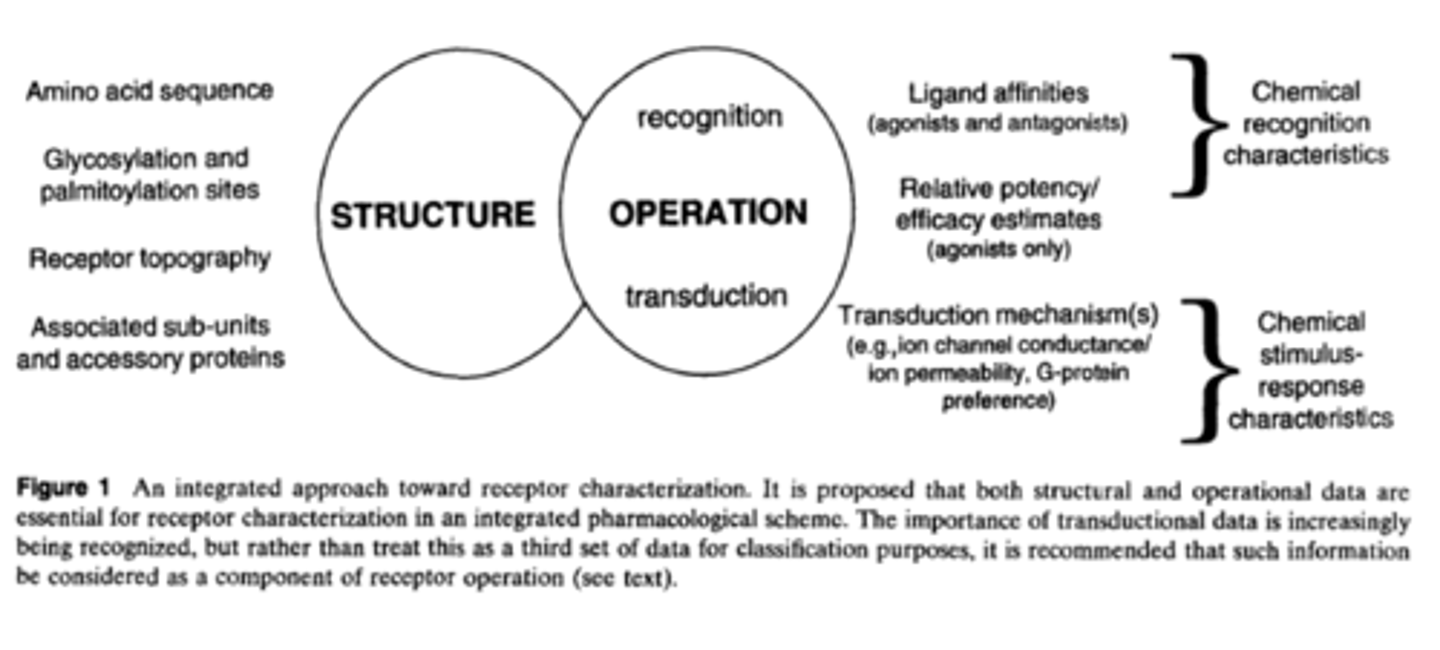
Major types of drug receptors chart
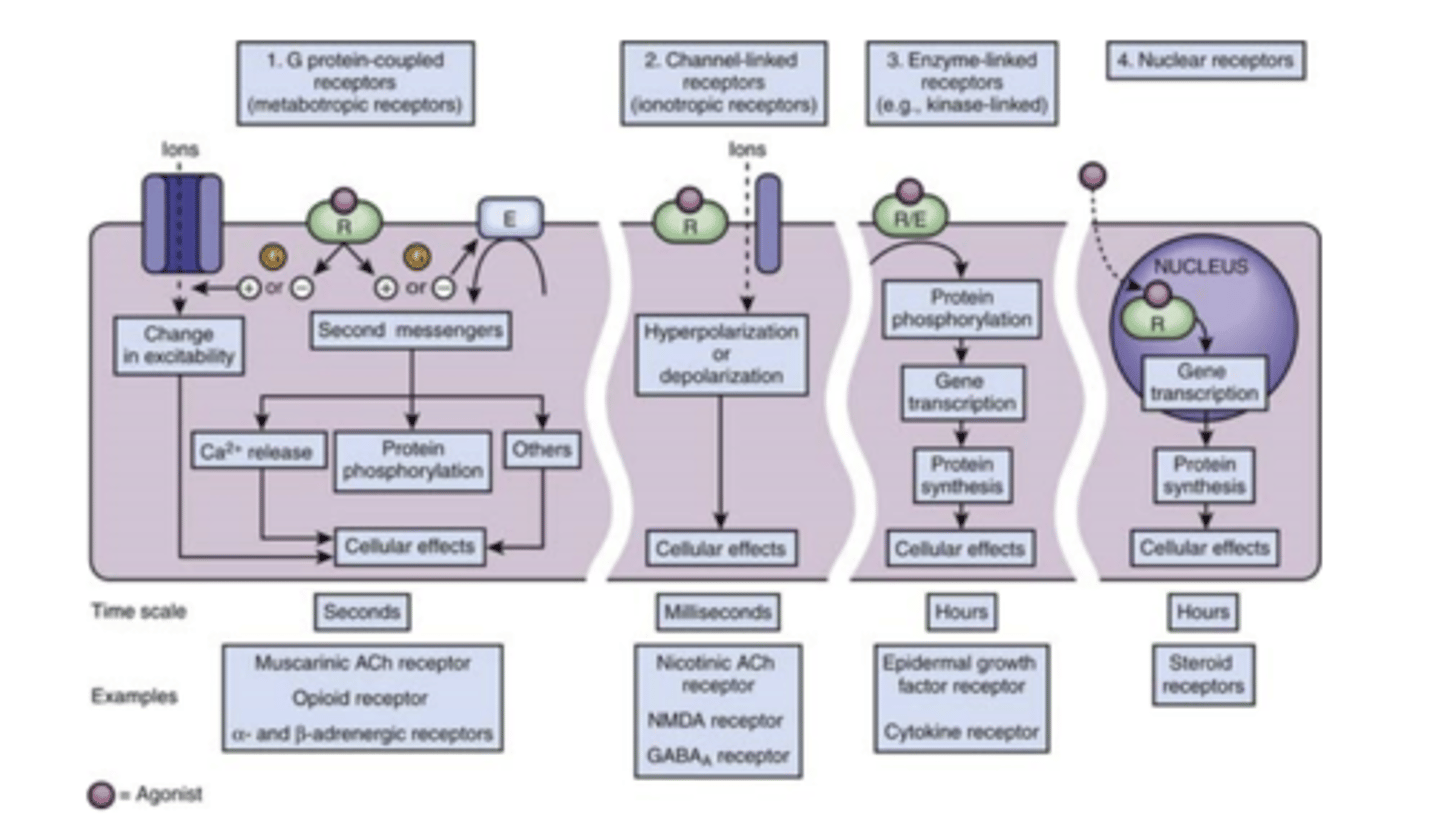
Receptors are subject to....
feedback regulatory controls
Desensitization (refractoriness or downregulation) often follows...
continued stimulation with agonists
T/F: Desensitization is only homologous
FALSE
may be homologous or heterologous
What does desensitization mechanism involve?
receptor phosphorylation, relocalization (internalization), alteration in rate of synthesis
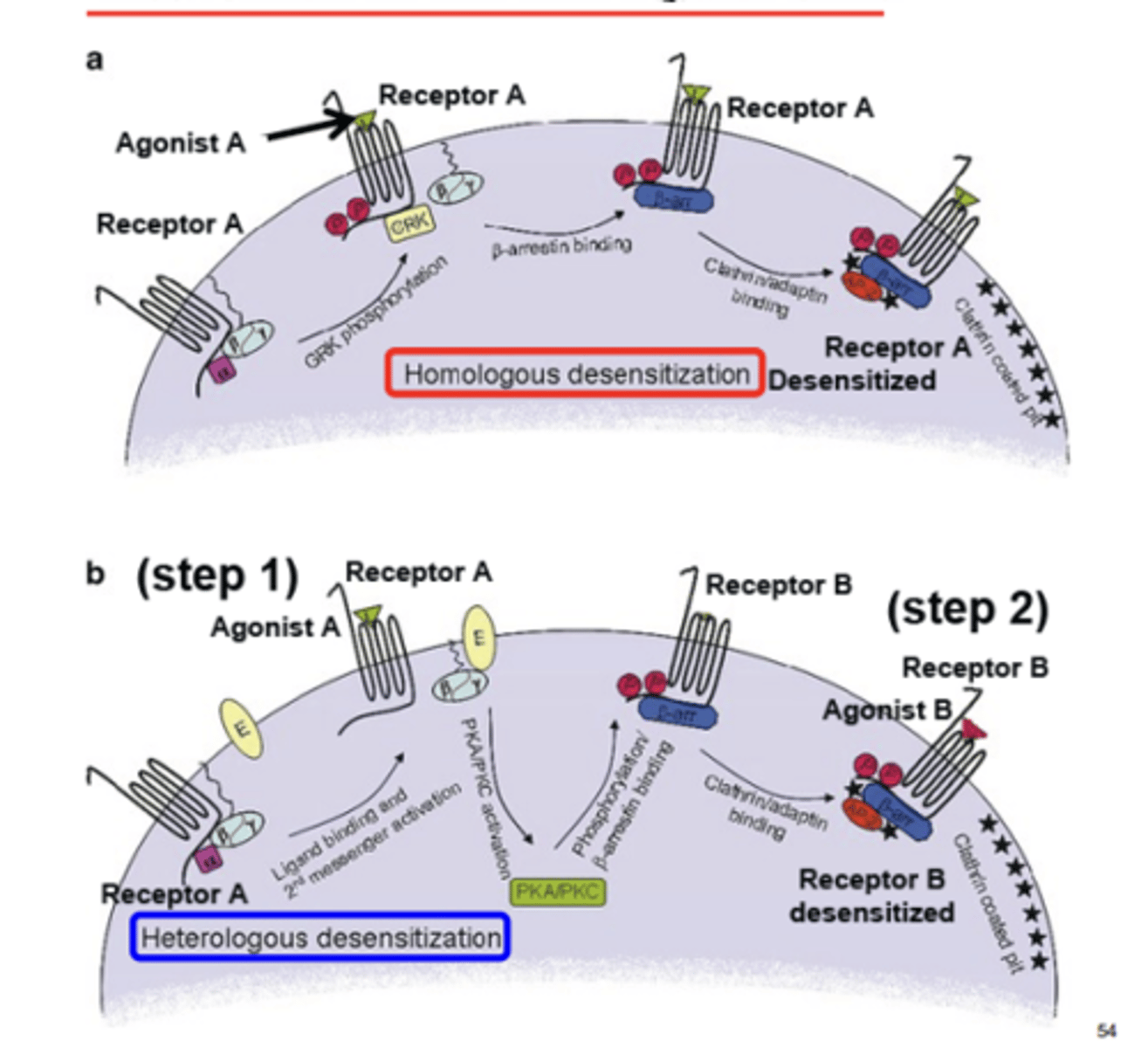
Desensitization can result from temporary ________________ of the receptor to _______________ or from fewer ___________ being synthesized
- inaccessibility
- agonist
- receptors
Homologous desensitization
adding an agonist for receptor A, desensitizes receptor A
- leads to phosphorylation of receptor
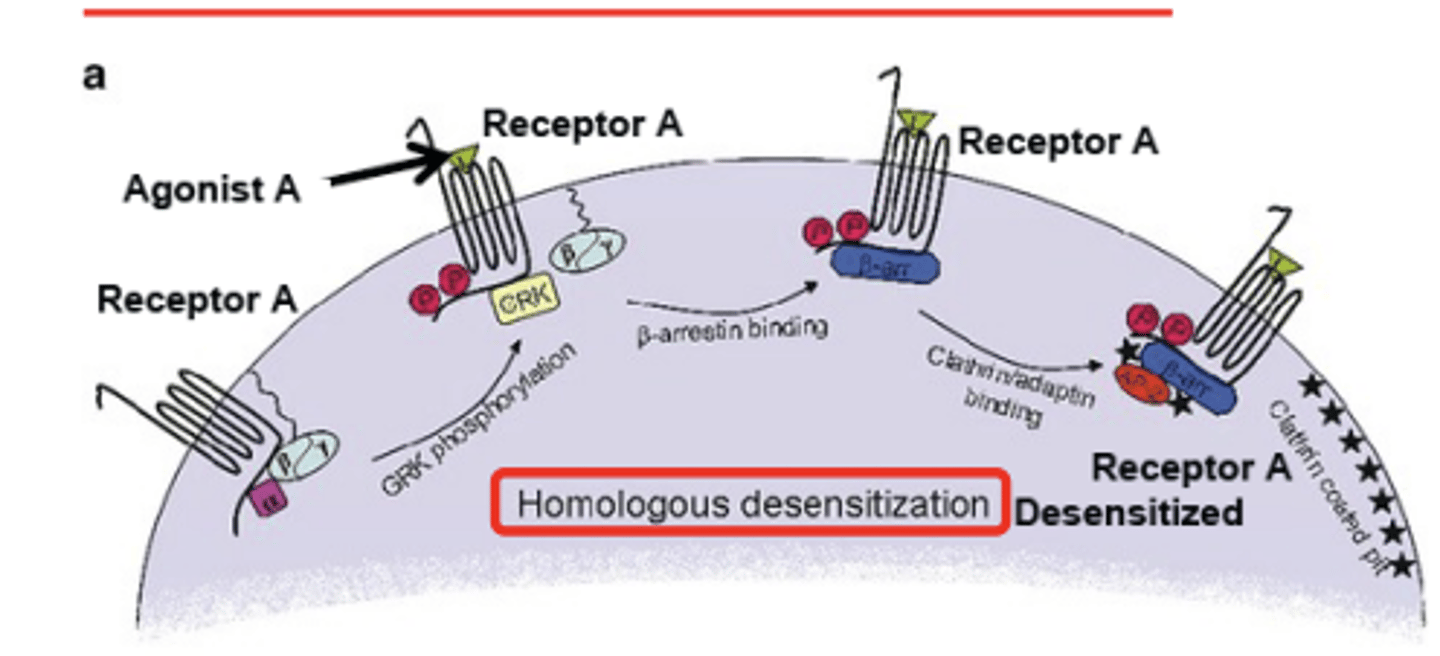
Heterologous desensitization
adding an agonist for receptor A, desensitizes receptor B
- triggers phosphorylation of a different receptor
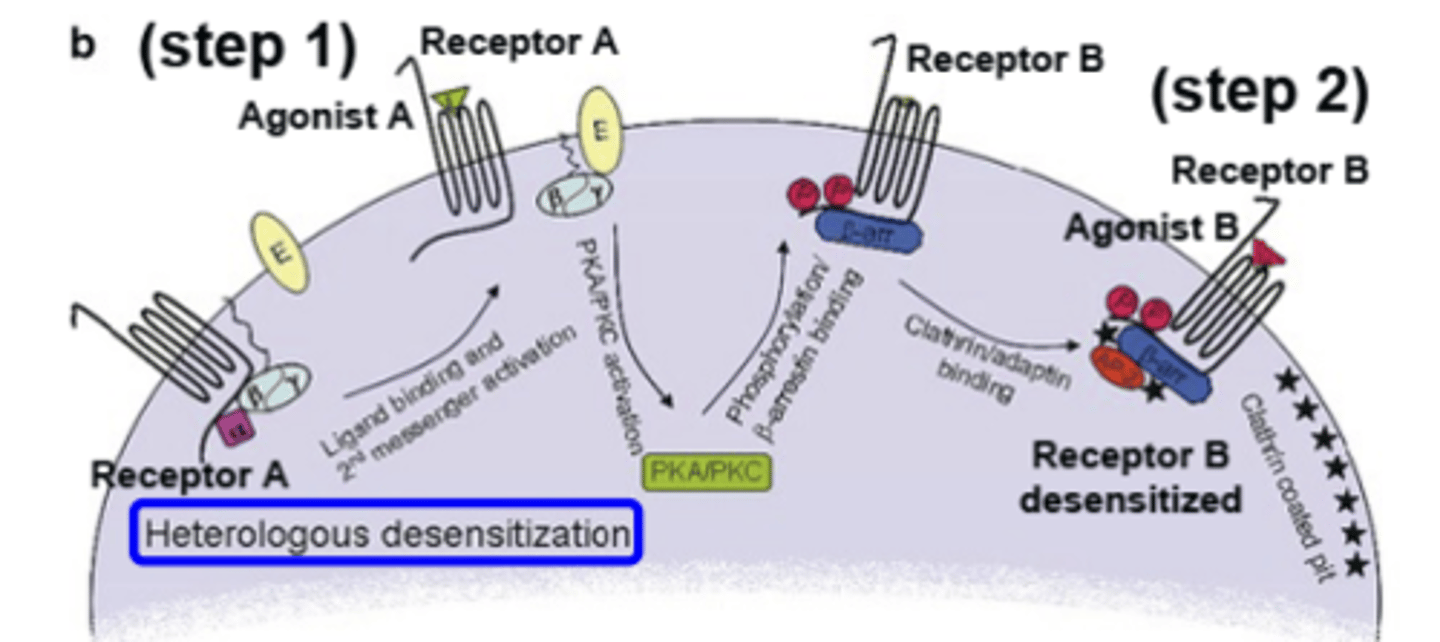
Homologous Vs. Heterologous desensitization graph differences*****
Homologous:
- Receptor A response lowers, B goes/stays up
- only one agonist is being affected
Heterologous:
- BOTH Receptor A & B go down, BOTH are effected
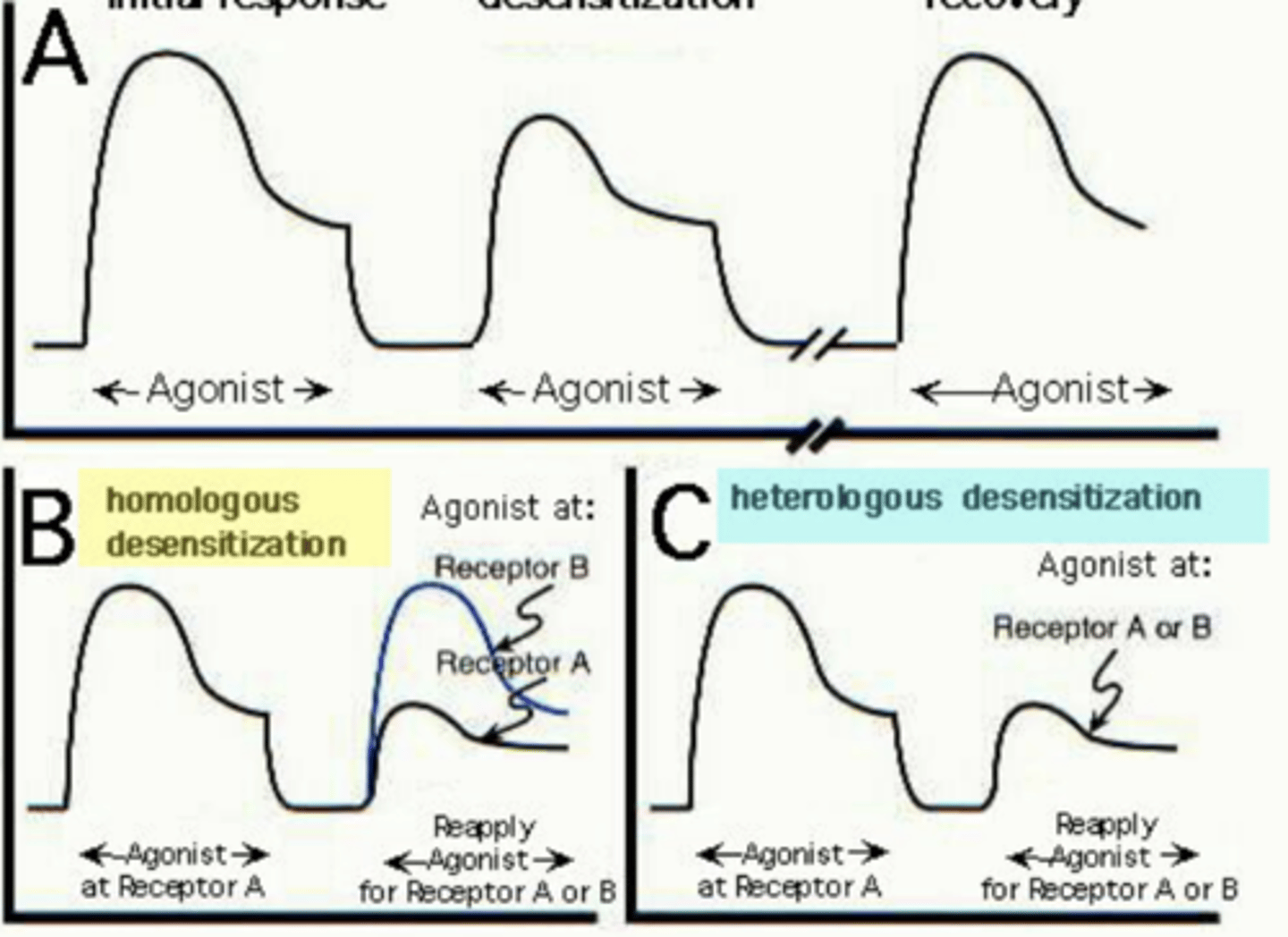
The GPCRs are typically desensitized by...*******
receptor phosphorylation through GPCR-associated kinases (GRKs) as well as other kinases (PKA)
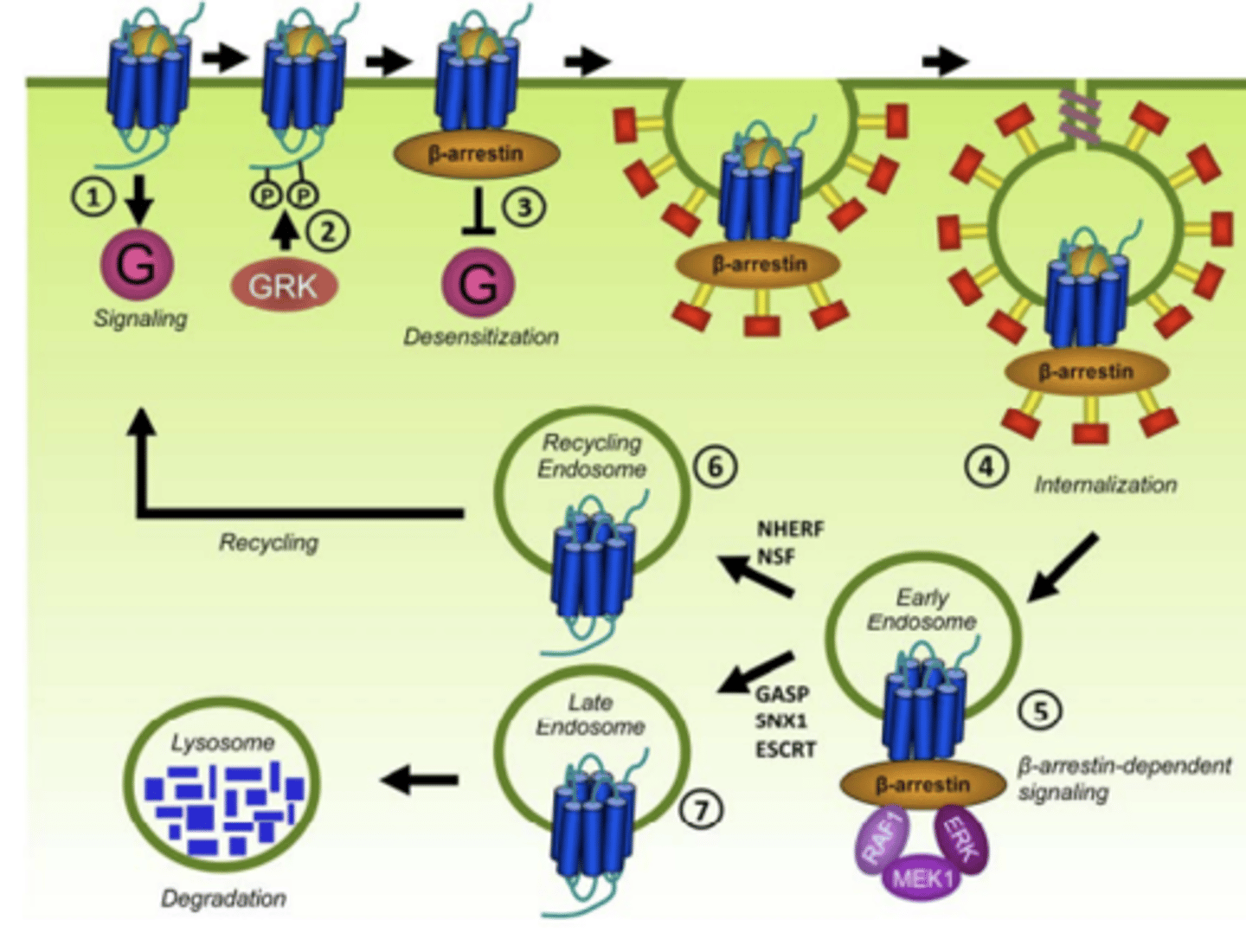
Desensitization of GPCRs: β-arrestins******
arrestin interacts with phosphorylated GPCRs and moves them into clathrin-coated pits for internalization and degradation
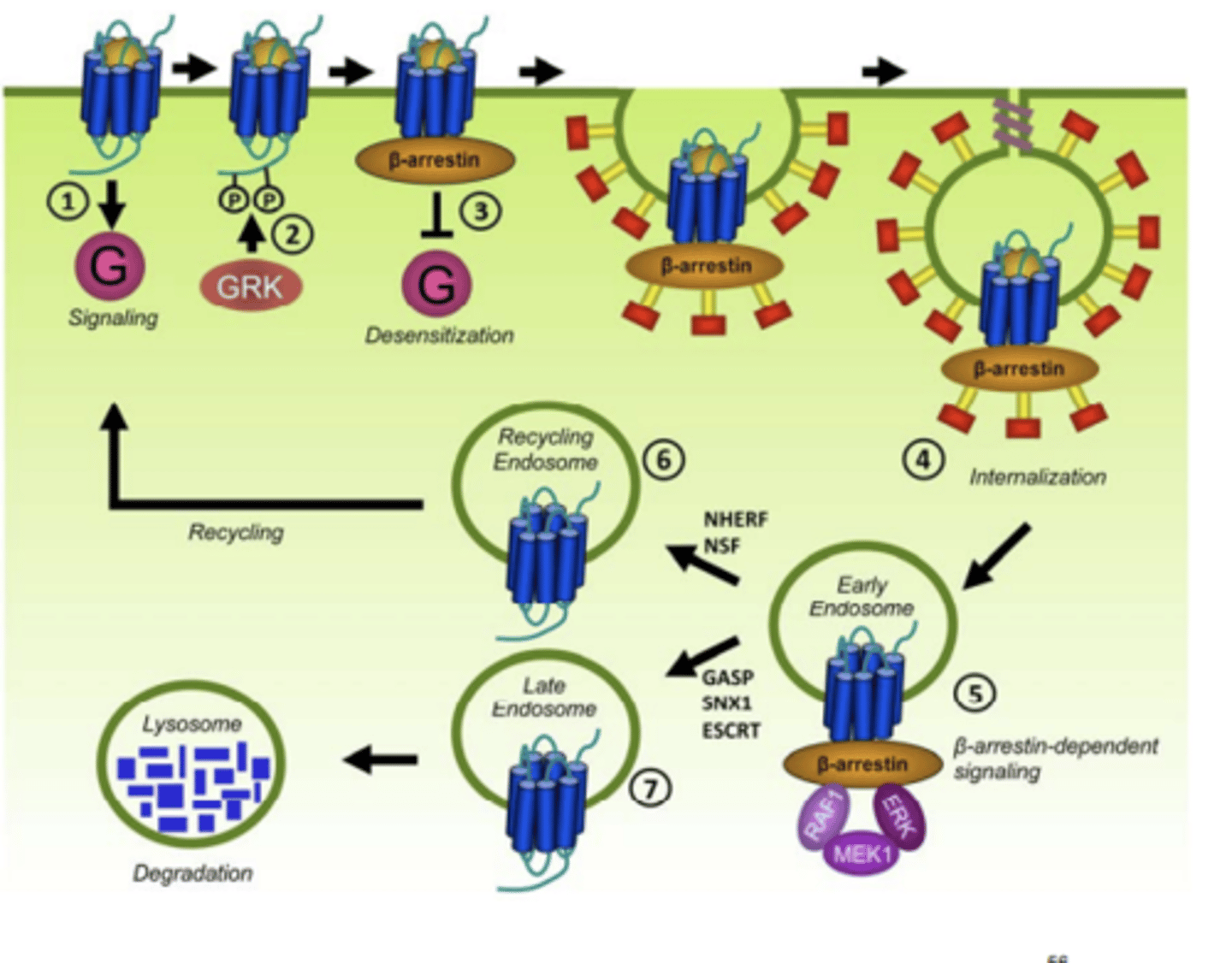
What plays a key role in triggering rapid desensitization of GPCRs? *****
Phosphorylation of GPCRs by specific GRKs
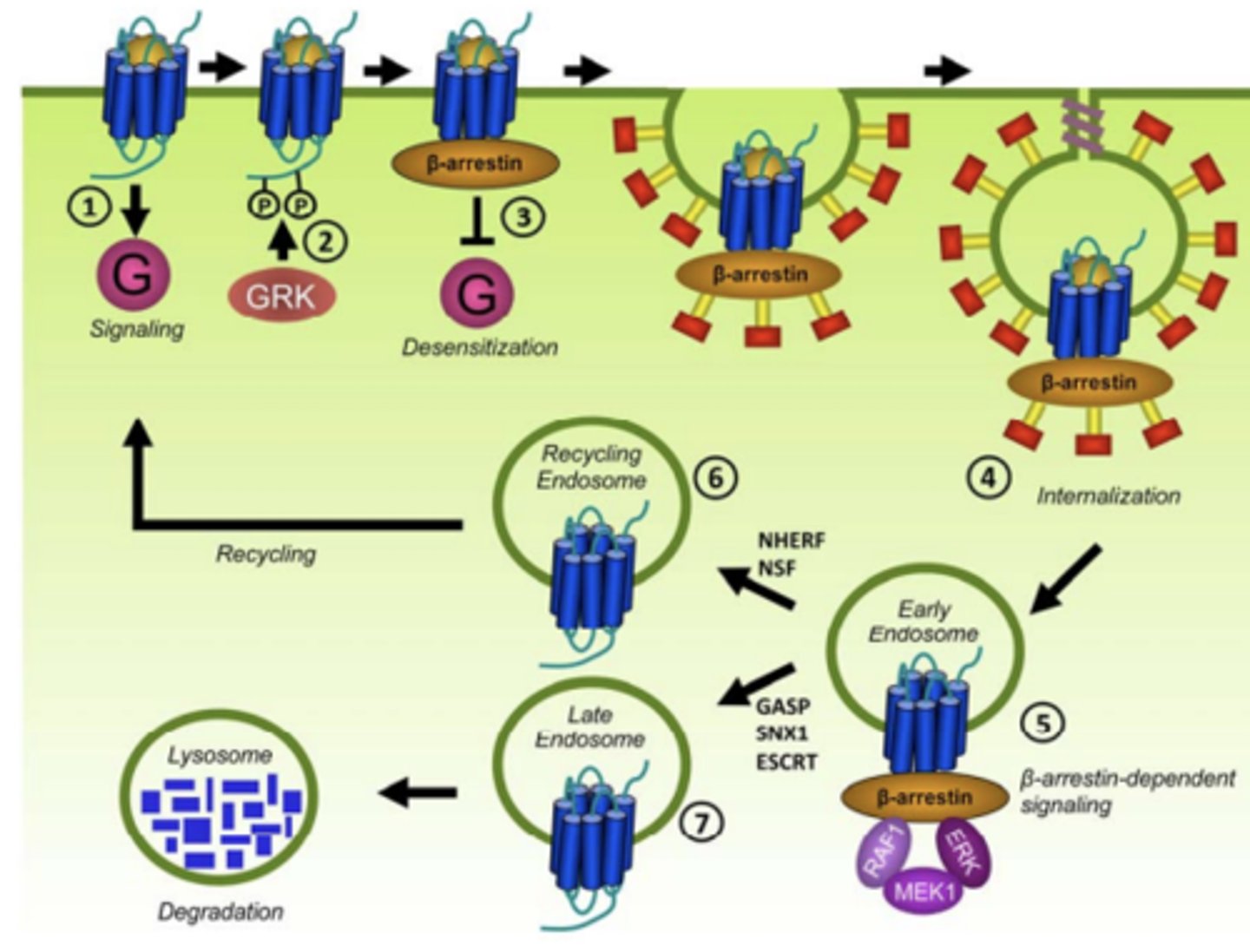
Drug-induced activation/inhibition of a receptor often has a lasting impact on the.....
receptor's subsequent responsiveness to drug binding
The ideal drug would interact only with a molecular target that causes the _____________________, but not with targets that cause _____________________
- desired therapeutic effects
- unwanted adverse effects
Many drugs act by _____________ or _____________ the actions of natural regulators/receptors
mimicking or blocking